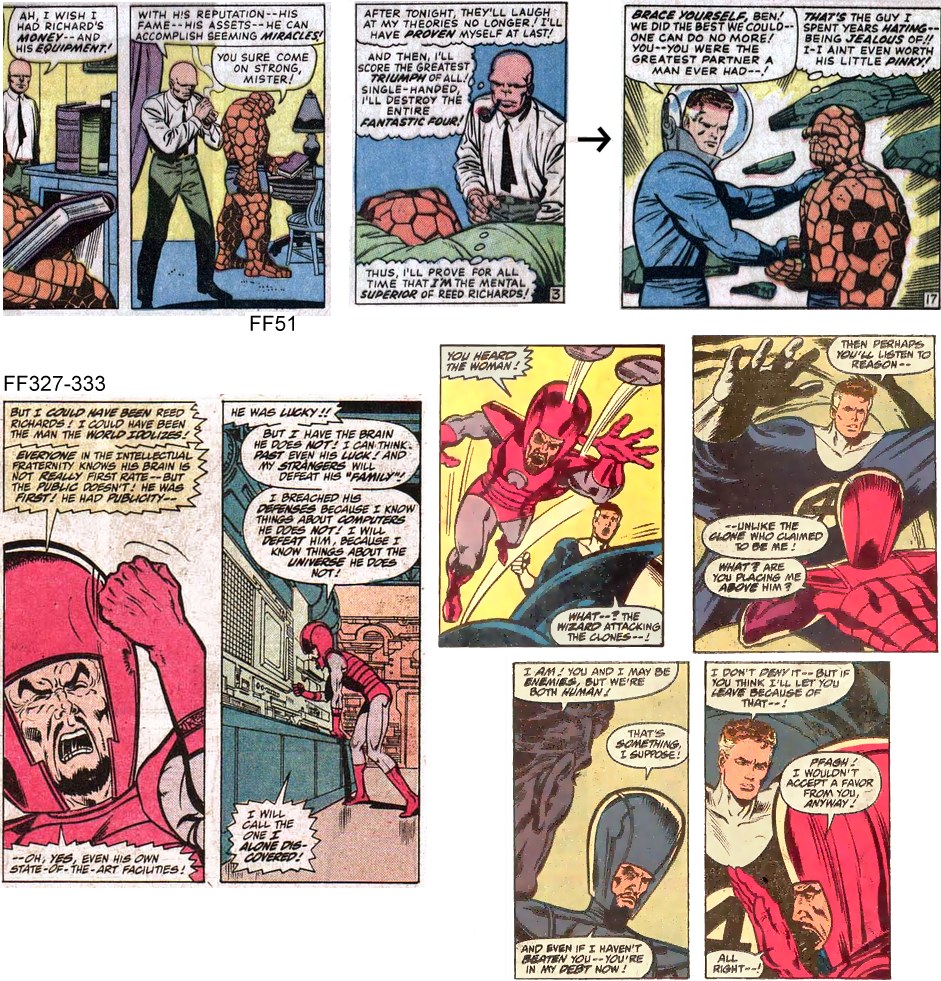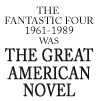







 |
 |
 |
 |
 |
 |
 |
 |


 FF322
FF323
FF324
FF325
FF326
FF327
FF328
FF329
FF330
FF331
FF332
FF333
FF322
FF323
FF324
FF325
FF326
FF327
FF328
FF329
FF330
FF331
FF332
FF333

Summary
In 1989 the Berlin
Wall came down. The cold war effectively ended, and America wondered
"what now"?
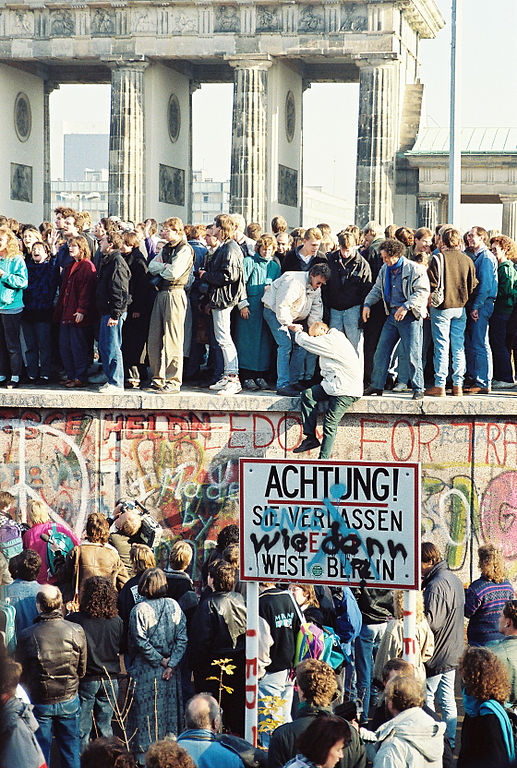
The Fantastic Four, the Great American Novel, is a product of the Cold War: when America finally became top nation. America had been growing in power for centuries, and its last major rival was the Soviet Union. Then 1989 saw the fall of the Berlin Wall: the loss of the Soviet's empire, leaving America as the world's only major superpower. For the first time in history, one nation gained dominance over the entire planet. Where does America go from here? The final issues of the Great American Novel reflects these questions:

With FF 322 everything went crazy. In the next couple of years we learn more about the Franklinverse, so we can look back and see what happened. In FF322 Johnny Storm was finally ready to lead the team, and Franklin panicked.
Why FF322 matters
Continuity ended with FF322. This is how we know:
F322 and the history of Marvel comics
Marvel comics reflected the zeitgeist and sold well. Just as superhero
comics always sell better in times of war whether it is cold or hot. As
the cold war declined so did sales of Marvel comics, though this as not
the whole story.
|
About these blue boxes: Behind the scenes: Marvel Comics in 1989
Byrne and looking backwards In the 1980s a new generation of writers had grown up reading a
certain kind of superhero comics and could not imagine anything
different. Byrne began the trend of looking backwards. After Byrne's run
editors did not know where to go next, so the made the twenty fifth
anniversary issue into a look backwards. It wrapped up of each
character's twenty five year story without any idea of what to do
next. This was especially obvious with the star of the story, Ben Grimm:
his own book had trued to move him forwards by mutating him more, and
this was instantly dropped. 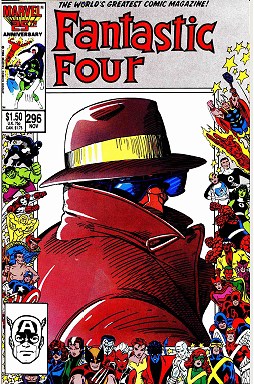
Despite this, Jim Shooter (editor in chief of Marvel comics) cared
about continuity. He presided over the only consistently successful
period (both
creatively and financially) since Stan Lee. But he lacked Stan's
silver tongue, and his desire for continuity upset a lot of
people: why did he keep saying "you can't do this" or "try that"? A lot
of creative people, producing their
best work under his editorship, felt they did not need him. So in
1987, Shooter was forced out. Writers then felt free to try wild new
ideas that ignored continuity. For full details, see the end of the Marvel
Universe. Steve Englehart tried to move it
forward Why didn't readers embrace change? Reed and Sue can never retire:
retire from what? The real problem is this horrific image. The art is beautiful (Pollard and Sinnott), but Reed is not a gardener! This image (from FF annual 21) makes absolutely no sense! A secret identity? The last time they tried a secret identity it was an absolute disaster: they ended up tortured by Mephisto! The whole concept of retirement is madness!
Yes, Reed needed to move on, but to new and greater adventures. In his defense, perhaps there was another reason for the gardening:
perhaps this was a cover for something much bigger? There is a trope in
fiction and in theology that the most powerful beings do not need to appear powerful. So in eastern religion the most powerful being might tend his garden. In his
Hitchhiker "trilogy" Douglas Adams describes God as a gardener pottering
in his shed, thereby maintaining order on the universe. Maybe that is where Reed was going? But Readers didn't see it. The new direction: backwards Civil war in Marvel Macchio's defense This is like the period between the golden and silver ages of superheroes: the old Torch has gone, we were left wandering in the dark with forgettable stories, waiting for a new Torch to light our way. Englehart on FF322
Steve Englehart
explained what happened in an open
letter to 'Amazing Heroes' (emphasis added): |
FF322: the story leaves the real world
The Fantastic Four, unlike other comics (including other Marvel comics) was always defined by realism. No matter how amazing the events, they were always believable. Every amazing story could really have happened in the real world. The science can make sense if smart atoms really do exist. The spaceship in FF1 only uses 1961 technology if we look carefully. When Terrax took the whole of Manhattan into space in FF242, Galactus then fixed things so that nobody remembered (FF243) . Examine any FF story before 322 and there will always be a get-out clause, it is always possible to believe that the stories occur in the real world. But that ended with FF322.
The Inferno story involved massive destruction, and every New Yorker experienced it. Unlike other major New York events (such as FF242) it was never completely reset: ordinary people still remembered. True, many of them coped by assuming it was a mass hallucination (according to Wikipedia), but the memory was still there.
Anybody who lives in real world New York has no memory of this, and no excuse for not remembering it. So the FF world left the real world at that point.and so the suspension of disbelief is broken. From FF322 the stories are no longer set in the real world.
1986: Franklin becomes aware of great
dangers
The late 1980s sees Franklin acting away from his parents, in
Power Pack. he becomes aware of increasing dangers, especially
involving mutants such as himself.He saw his friends (other
mutants) threatened or killed in the Mutant Massacre crossover
(1986) and again in the Fall of the Mutants crossover (1988).
Remember Franklin's face on those posters advertising the series?
They nearly killed him.
1987: The Twelve - Franklin's power is confirmed
The story of "the Twelve" is the story of twelve mutants who will
save the world in the future. It confirms that future Franklin, as
a being called "The Twelfth" will have greater power than any
other mutant will ever achieve. That is, greater than "omega
mutants" like Phoenix (or as later explained, the ones who handle
the phoenix force.)
1988: the crisis reaches its peak. Something has
to break.
1988 was the high point for anti-mutant danger: not just Fall of
the Mutants, but the discovery of Genosha and the 1988
"Evolutionary War" genetic bomb crossover event. Wherever he
looks, Franklin sees ever increasing danger.
Franklin's
reality
We need to understand the world from
Franklin's point of view. He does not see reality as the rest of us do:
Franklin and hell
Franklin Richards gained his power from Annihilus, "the living
death who walks," in the negative zone, a kind of scientific hell.
He was neglected by his parents and raised by a witch. He often
finds himself in a hell of some form (possessed by a demon in
FF223, trapped in Mephisto's realm in FF276 and annual 20, in hell
in FF500, etc.) He sees alternate realities (i.e. ghosts are all
around him) and often sees members of his family die in these
realities. He was raised in Elsewhen, a hellish looking place, and
grew up jumping between hellish war zones. His principle
enemies are Annihilus (who longs for his power) and Mephisto (who
fears him). His life, particularly in other dimensions or ages, is
characterized by failure and rejection. It seems reasonable that
any reality that conformed to Franklin's mind would be full of
demons. It should be noted that when the Franklinverse fully took
over (the 1990s) Marvel comics became much darker.
The name for Franklin's reality:
Otherplace
OK, what should we call this demonic world that adapts to a
person's psychology, where time is messed up? Marvel calls such a
place "Limbo" or "Otherplace." According to Wikipedia: "Limbo's appearance and physical
laws are highly variable, and determined by the power and
personal taste of its ruler." and "Although Otherplace has a linear
history, time within it is not rigid. Many points in its past
and future are connected through naturally occurring temporal
rifts, and its present is relative to the individual."
Elsewhen and Otherplace
Franklin was raised in Elsewhen, a place that is never fully
described, but it's at a nexus of realities, looks a lot like
hell, and is ruled by a well intentioned ruler (he guards the
sacred time lines) who nevertheless acts like a violent barbarian.
If Elsewhen is not a corner of Otherplace then, as a nexus of
realities, it is only a jump away.
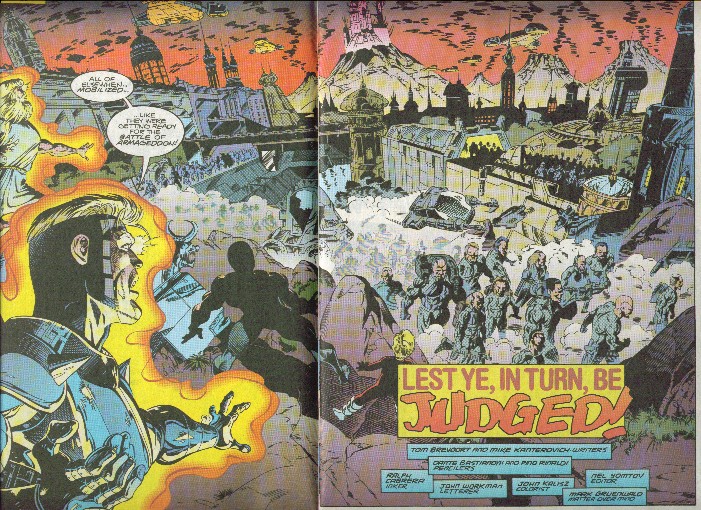
His inner demons
Limbo is full of demons. Where did they come from? Clearly they
represent Franklin's inner demons, but how do they arise? We can
see the process in the every example we have of Franklin's
world:
Heroes Reborn was like
Otherplace
The Heroes reborn world had a fake history of millions of years
whereas in fact it was just one year old. In other words, normal
rules do not quite apply. Within one year it was ruled by Dr Doom,
a sorcerer who Johnny implies is like "the devil himself" (volume
3, 53, last page).
The Marvel Universe after 1989:
This quickly became a darker, more chaotic place. Sue Richards
commented on this several times in DeFalco's run. Familiar
characters became weird (bony Wolverine, totemic Spider-Man, etc.)
or apparently evil (e.g. Iron Man and Mr Fantastic during Civil
War). Also, death was no longer meaningful, and an entire
sub-universe appeared that was populated by zombies.
Nathanial Richards understands. Nathaniel is the only "good guy" who seems at home in Franklin's world, jumping between the time streams. And the power seems to corrupt him: while he believes he is doing good, he often appears to be a villain. Give these realms another hundred years or so and they would appear utterly confusing and demonic to outsiders. As for actual demons, think back to medieval times: all super beings would have been considered demons: a demon is only a point of view.
1989: time stretches until it breaks
Time stretched since the late 1960s, and 1989 is the last straw.
The poster child for old heroes is Reed Richards: he fought in
WWII (see FF11). Even if he joined at age 17 in 1945, in 1988 he
would turn 60. 59? Yeah, just maybe. 60? That's a step too far.
Franklin has to either return his family to real time (and real
danger) or completely detach them from reality. Franklin turned 21 in 1989 (in real time). He's an adult now, and
wants to make his mark. He now has experience as a superhero (in
Power Pack). It's time to act.
The original five acts were now complete: Reed and Sue had put Franklin first, Ben had overcome his demons, and it is now time for the next generation to take over. Johnny Storm has asserted his independence from Ben, and in FF322 he proves himself ready to take over the team. He takes on an unbeatable foe - and wins, unlocking his true power for the first time:
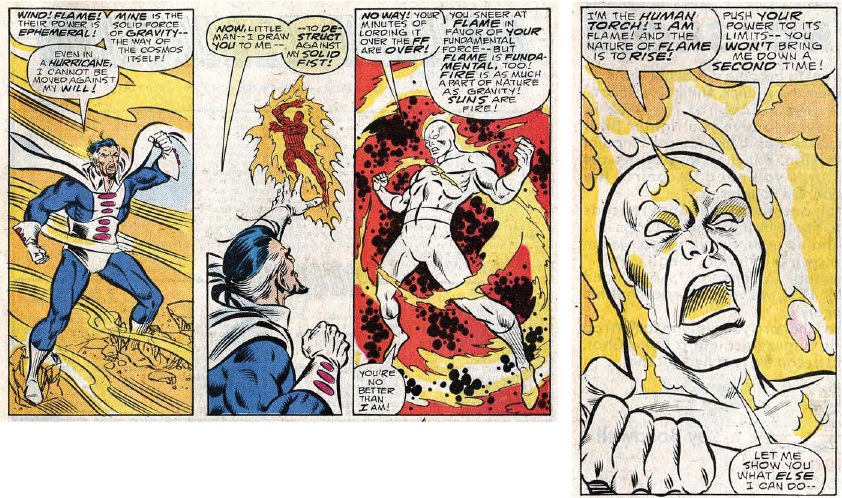
At first this appears to be a writers' mistake - flame is just hot matter, and matter cannot defy gravity! But look closer to see what is really happening here.
First, regarding flame:
Johnny has never had normal flame, though he may believe it to
be. The evidence:
Next, regarding powers in
general:
All superpowers are variations on the
same power: the ability for smart atoms to maintain their
normal state in opposition to extreme force, by calling on cosmic
energy. All other powers are variations or side effects of this.
Graviton is a particularly clear cut example of this: his whole
power is to increase the mass of atoms. But of course at the
nuclear scale mass and energy are the same thing (hence particle
rest masses are measured in electron volts, a unit of energy). So
Johnny at his most extreme has the same power as graviton, though
he does not know how to use it as such (although becoming lighter
than air when flaming on should have given him a clue). As I see
it,. all powers are identical, and they are only expressed in
different ways because their users have different experience and
understanding.
FF322 in context:
FF322 is a beautiful piece of work, when seen in the wider
context. With issue 300 Johnny finally put away his last childhood
aspects and became a man, a responsible, forward looking man. In
the next few issues Ben pushed him to the limit emotionally (by
bringing back Crystal), and Johnny, free of Sue and Reed, began to
assert himself. It is my belief that the first 28 years of the FF
inevitably imply that Johnny must be the leader of the new FF, and
Ben's leadership was an interim position. In FF322 we finally see
Johnny emerge from his cocoon, as it were, with Ben and Sharon
both rendered helpless. This is Johnny's story! he pushes himself
to the limit: not by burning brighter than ever (he had burned
brighter before) but by forcing his inner being to release more of
his true nuclear power. Yes, he was counteracting gravity in a big
way for the first time. He was spectacular!
More evidence that this changed Johnny at a fundamental level is
that he was then unable to flame off. Clearly the merging with the
magical realm had something to do with it, but I interpret this as
a merging with Otherplace, Franklin's personal dimension, so the
merging was not only a cause of major changes but was partly
caused by them (Franklin sees big changes, cannot handle it, so
gets involved to an unprecedented level starting with FF322).
Seeing his uncle Johnny start to blossom would freak him out, and
perhaps triggered him to force the crazy and clumsy retcon where
Reed suddenly decides to come back. Reed's out of character
behavior when apart from them was no doubt influenced by Franklin
as well. The kid has issues, and I don't mean the 22 page stapled
kind.
Why Franklin panicked:
Franklin is caught, as the story title suggests, between a rock
and a hard place. he is terrified of the future, yet
the past is now closed to him: the old reliable status quo has
gone, and the long awaited new order is finally here. Franklin
must now grow up. He panics! He causes Johnny to lose control
of his powers. He allows the Franklinverse to completely take over
(Graviton, as he said, could have stopped it: that was no doubt
Franklin's original plan). He then shunts Johnny into deep space.
He forces Reed and Sue to come back and take control again.
It is a clumsy, crazy, short sighted attempt to delay the
inevitable, but that is how Franklin's terrified mind works. In
this issue he finally pushes the entire Marvel Universe over the
edge into chaos: the chaos of the 1990s, and it is not going
to be pretty.
One line summary
This is the issue where we saw the real Johnny, and Franklin (behind the scenes) panicked.
INFERNO ...and why it matters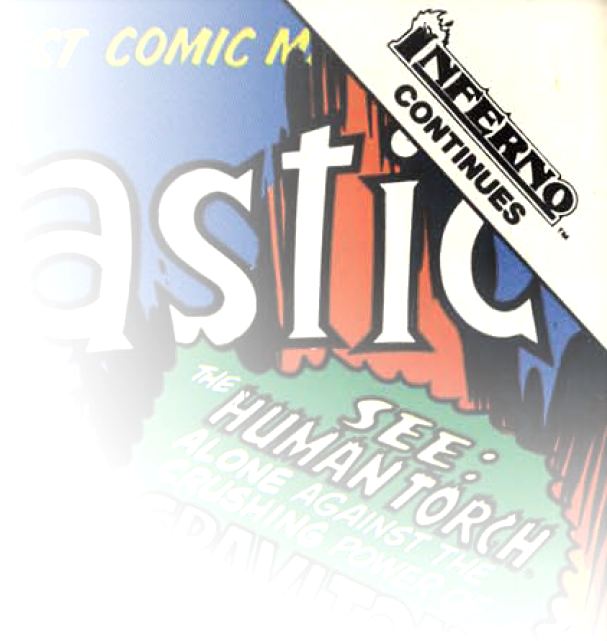
The historical significance of
Inferno "Inferno was Marvel’s first line-wide crossover not driven by a limited
series and including direct crossover between monthly issues of ongoing
titles." (source) There
were a few crossovers before this, but with the exception of "Secret Wars
II" they were limited in scope. Secret Wars II was the first big
cross over that forced writers of every major title to ignore
their story and shoe-horn in something different. It was
intended as a one off, but it became a commercial hit. So they tried
another big cross over, but limited to the mutant books: "Mutant Massacre" was another hit, so they did "Fall of
the Mutants,"
again limited to mutant books When that was a hit too it dawned on
every editor that this was a way to raise sales. "Originally we weren't going to do a big crossover the following year," said Louise Simonson, "but 'Mutant Massacre' sold so well that Shooter told us to do another. That became 'Fall of the Mutants' and the next year was 'Inferno.' I think a lot of people wanted a play in that one." - Marvel Comics, the Untold Story, p. 307, footnote. So the culture changed. Instead of crossovers being rare or limited special events, crossovers became the mainstay of Marvel. Almost every summer had a big "event" story, and it all began with Inferno.
Inferno: where stories became impossible to follow "The two stories collectively called the X-Men: Inferno crossover are arguably the last entry point to the X-Men franchise before it became hopelessly convoluted." (source) Some long time readers on the Classic Comics Forum agree. User "coke & comics" wrote:
"There are infrequent crossovers, but they are mostly readable on their
own. Mutant Massacre is a light crossover in that sense. Fall of the
Mutants is more of a thematic crossover. Each title can be read
separately. "It was somewhat enjoyable for a while, but it got more and more miserable and ugly until I finally ditched it all around Fall of the Mutants, Inferno, Mutant Massacre... I can't even remember the sequence because they all blur together for me." This is all part of the bigger picture whereby The Marvel Universe (that is, believable continuity) was dead by 1991. Inferno: story summary"A demon from Limbo, N’astirh, while warring with Illyana’s tormentor S’ym, has come up with a scheme to link Limbo to Earth using twelve infants as a sacrifice. N’astirh also unlocked some of Madelyne Pryor’s powers to transform her into the Goblin Queen while also using her son Nathan as one of the infants in the portal scheme. When this plan goes awry, N’astirh delivers the boy back to Madelyne, who has fully embraced her powers and brought out the negative influences of the Uncanny X-Men, putting some of them in her thrall. That’s just about the simplest I can reduce the plot to. [...] It all leads back to Mister Sinister; this is his first major plot line so that’s not the cliché it would later become." (source)Mr Sinister and Franklin Mr Sinister sounds like an angry version of Franklin. Chris Claremont wrote: "Dave Cockrum and I went over ideas, and what we were coming towards was a mysterious young boy - apparently an 11-year-old - at the orphanage where Scott (Cyclops) was raised, who turned out to be the secret master of the place. In effect what we were setting up was a guy who was aging over a lifespan of roughly a thousand years. Even though he looked like an 11-year-old, he'd actually been alive since the mid-century at this point - he was actually about 50 [...] So he built himself an agent in a sense, which was Mister Sinister, that was, in effect, the rationale behind Sinister's rather - for want of a better word - childish or kid-like appearance. The costume... the look... the face... it's what would scare a child. Even when he was designed, he wasn't what you'd expect in a guy like that." (source) An adult trapped in a child's body with a child's thoughts. Sounds familiar? "The character plays a major role in the Inferno crossover, where it is revealed that Sinister cloned Madelyne Pryor from Jean Grey for the purpose of having her mate with Cyclops and produce a child, their son Nathan; Sinister also reveals to have manipulated Cyclops' life since early childhood." (Wikipedia) Sounds a lot like Franklin arranging for Johnny and Alicia to fall in love (see comments to FF333 and elsewhere). The result is terrible continuity: see the discussion of Madelyne Pryor, below. "Classic X-Men #41–42 (Dec. 1989) details the role Mister Sinister played in Cyclops' life at the orphanage in Nebraska. The story features a boy named Nathan who is obsessively fixated on Cyclops — and whom Claremont intended to actually be Mister Sinister." (Wikipedia) Nathan was Franklin's grandfather's name: he plays a key role in raising Franklin (in deFalco's run) Franklin's dimension merges with the Marvel Universe
Inferno and Madelyne Pryor Phoenix is important to the Franklinverse. Franklin unconsciously stretched time and "fixed" things from the moment he was born (1968), and by the late 1980s this began to cause noticeable changes. The most famous example, because it came as such a shock, was the return of Phoenix (in FF286 then X-Factor 1). There isn't space to discuss why Phoenix is so important to the Marvel Universe, but that would make a long and hopefully fascinating essay in its own right. More about Madelyne "The original Madelyne
storyline was that, at its simplest level, she was that one in a
million shot that just happened to look like Jean Grey, [a.k.a.
the first Phoenix] ... I mean, it's a classical theme. You can
go back to a whole host of 1930s films, 1940s, Hitchcock
films—but it all got invalidated by the resurrection of Jean
Grey in X-Factor #1. The original plot line was that Scott
marries Madelyne, they have their child, they go off to Alaska,
he goes to work for his grandparents, he retires from the X-Men.
He's a reserve member. He's available for emergencies. He comes
back on special occasions, for special fights, but he has a
life. He has grown up. He has grown out of the monastery; he is
in the real world now. He has a child. He has maybe more than
one child. It's a metaphor for us all. We all grow up. We all
move on. Note that for Claremont change is normal and healthy. Given totally free reign he would have done something similar to Englehart: allowed Reed and Sue to move on, allowing the team to move forward. Madelyne Pryor and Sharon
Ventura: parallels The big cross overs after Inferno
FF277 and FF322A similar event in FF277 suggests that Franklin may be involved. FF277 also had a merging with a demonic dimension. Franklin had moved out of the Baxter Building, to a small house. This was a crazy idea, and sign of his parents' stress. Reed had earlier promised to study Franklin's powers (FF229) and promised to let Franklin join the team in a couple of years (annual 14), but instead he took Franklin to somewhere vulnerable, left him alone while he went off to work, and waited for the house to be attacked. Franklin was captured by magical powers yet again (as happened in annual 14 and 223: just months earlier, in Marvel Time). Franklin unconsciously controls the Marvel Dimension, so how did this experience play out in the physical realm? Answer: a demonic alien dimension began to merge with this one. It's all pretty explicit in FF277, where Franklin's condition is mirrored in the world above. In FF322 the same thing happens again. Reed finally decides to devote his time to Franklin, but what does he do? The only clues we have (a splash page and stories in other comics) is that he chooses a tiny house with insufficient technology to either protect or study Franklin. Then he quickly takes work as a superhero again, reversing his promise to put Franklin first. It's all happening again. But this time it's
different |
Other points to note in FF322:
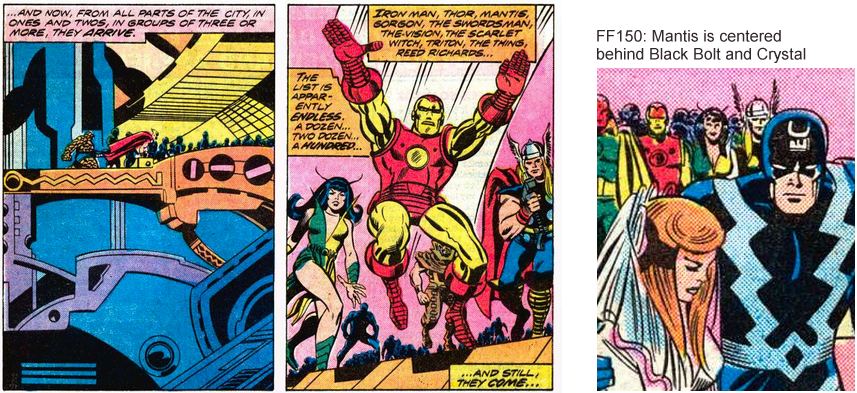
Mantis, Kree, Cotati, etcA brief history of Mantis |
Religious symbolism
Nathan Adler, or How Would You Fix, explores the religious symbolism of this issue:
"In Avengers #129 by Englehart, after Mantis has hooked up with the Swordsman and tags along when he joins the team, Kang the Conqueror turns up, heralding his arrival by a huge star over Avengers mansion – reminiscent of the natal star in the East from Christ’s nativity – having seemingly worked out that one of several women will give birth to a very significant child. Kang is pretty keen to father this child. It then turns out that Mantis is to be the Celestial Madonna, with the Cotati obligingly providing her with a husband, in the form of her dead lover the Swordsman reanimated by a plant. During the selection of Mantis as Celestial Madonna from the various candidates, Steve Englehart asserted that she was found most appropriate because she’d spent years working the Saigon bars and being treated as meat, whilst Moondragon (and possibly Wanda) were too pristine and perfect. Now, in making Mantis a whore, Englehart was digging back into a very ancient tradition. The bride of god who births a god is often seen as personifying wisdom (and Mantis has a certain serene understanding about her), and is often linked to prostitution. And that’s why Mantis was sent by the Priests of Pama to live on the streets and survive as best she could. Now the Christian church would perhaps argue that in using the pure Mary of Nazareth the vessel for Christ, God was leading the world from a half-understood truth to a fully revealed one. Wisdom is no longer soiled or depraved by the sins of the world, but is made pure and spotless as it is meant to be. There are certainly less dark undertones in the Gospel accounts of Christ’s birth than in Englehart’s modern fable. In choosing the old, cruel, way, it would appear the Cotati show their true colours. Englehart carries the story through his run on Silver Surfer, and the child eventually gets taken from Mantis and then continues it in his F4 run, but you can tell he intended the whole Celestial Madonna thing to be far from over. And that the child was going to be seriously bad news if it was brought up to serve the Cotati.
"Then
Englehart is forced off the title and Avengers West Coast, but Bob
Harass brings her back during The Crossing as a scheming bitch-queen
mistress of Kang. Just after the Crossing, in the letters
page of an issue of the Avengers, it was strongly hinted that the
offspring of Mantis was somebody that we were already familiar with in
the Marvel Universe and that it would blow us away when we found out
whom. Obviously things changed dramatically with the whole Heroes
Reborn thing and this storyline never came to pass.
Englehart’s story here
parallels the Gnostic tradition that the Holy Spirit was feminine in
nature, and that the personified apocryphal figure of Wisdom was the
third part of the Trinity, the female companion to the male
Christ. Whilst Wisdom was held to have been manifest in the Virgin
Mary, the pure mother of Jesus, she was equally seen to have been
manifest in Mary Magdalen, the whore who became Christ’s
companion. And the Gnostic writings go far beyond the Christian
Gospels in describing the relationship of Jesus and the Magdalen,
depicting her as his principal disciple to whom he revealed secrets
untold to Peter, and even as Christ’s wife and the mother of his
child. Bear in mind that this is all based on the “Holy Blood,
Holy Grail” hypothesis which speculates that the Templar secret was that
the bloodline of Jesus and Mary Magdalene formed the Merovingian
dynasty of early France, and suggests a continuous secret plot to
restore the present descendants to world rulership. Anyway, there
was a Gnostic idea that wisdom, which was female, was debased in the
sinful world of the flesh, and was degraded into prostitution. The
“Templar conspiracy” also interprets the Grail legend as referring to
Christ’s bloodline. Was a parallel perhaps being drawn between the
Avengers and the Round Table, I mean what are the Avengers but the best
and noblest warriors of the realm (Earth’s Mightiest Heroes), banding
together to protect the land and fight its enemies. Further
parallels can then be drawn to Kang’s literal plan to conquer Camelot in
Strange Tales #134."
Historical symbolism
The 1980s are known as the time when "the Christian Right" gained great influence in American politics, with its rapture theology. Critics say that politicians used abortion as a wedge issue to get votes. Obviously it would be too controversial for Englehart to use directly Christian references, but by putting it all in a New Age context it makes the story safe. Traditional Christians can see it as a critique of New Age beliefs (the mad priest is obviously not Christian), whereas others can see it as a criticism of any religion they dislike. Interesting stuff indeed.
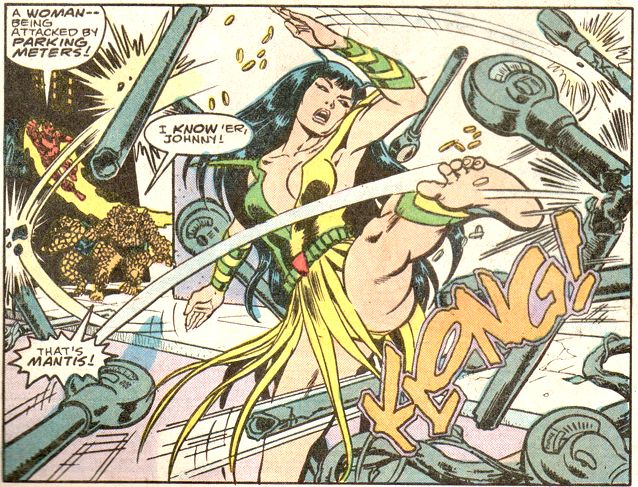
Oh, and the nature woman attacking parking meters? Such symbolism!
Natural life versus the controlling state and machines. the 1990s were a
period where the rebellion of the 1960s and 1970s gave way to the
conformity and crushing rat race of the 1990s and 2000s. Great stuff.
Dr Who In the Inferno story the FF
universe merges with a different dimension. Look at the
sound effect created by Kang's ship: TARDIS! 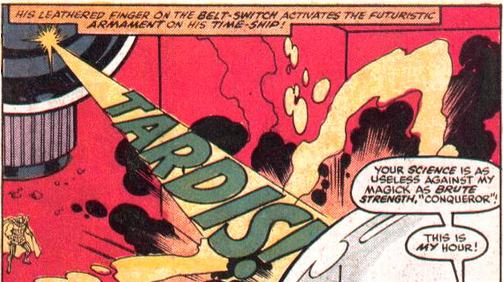
Is this a coincidence? No. Soon after (in FF338) the FF
try to fix continuity, and meet Death's Head. Death's Head
is from the Dr Who Universe. In Death's Head 9, Dr Who
leaves Death's Head with the Fantastic Four. Dr Who is a friend of Reed Richards, and gave him some TARDIS technology:
Some officially sanctioned Dr Who books refer to the FF
universe. "There have also been a few
sly references to Marvel characters within some of the
books." (- source) For example, the Dr Who novel "The Quantum Archangel"
(published in 2001) contains "a reference to 'Pym
particles', which hail from Marvel Comics and are named
after Hank Pym, a.k.a Ant-Man (and Giant-Man... and
Goliath... and Yellowjacket!), and a reference to the
Shi'ar Empire, also from Marvel." (source)
The Who novel "Millennial Rites" (1995) has its roots in
X-Men stories, and "Doctor Strange from Marvel Comics and
John Constantine from DC Comics appear in cameos." (source)
Note that Pym the X-Men and Dr Strange have all appeared
several times in the pages of the FF. More famously, Captain Jack Harkness (occasional guest
star in Dr Who and star of Torchwood) is named after
Agatha Harkness, nanny to Franklin
Richards, time jumper and "psi-Lord". "RTD [writer Russel T. Davis]
confirmed it in a text message to John Barrowman while
the latter was being interviewed on the Jonathan Ross
radio show. [BBC
Radio 2. 2006-10-21] Ross [a noted comics fan] had spotted the
connection and John Barrowman asked RTD - should he be
listening, which he was - to send him a text message to
his mobile. After a commercial break they announced that
RTD had sent a text confirming that Agatha Harkness was
indeed the source for the name." (-
source). The FF and Dr Who - the same universe? Really? Can we really say that the FF is in Dr Who continuity?
Yes, because the Dr Who canon is flexible and open. "The producer for the
television series from 2005 to 2009, Russell T Davies,
has claimed that he's 'just the writer...I've got no
more authority over the text than you!', saying '(Canon)
is a word which has never been used in the production
office, not once, not ever' He also said that
considering the Doctor Who audio plays as being
un-canonical is both 'boring and idiotic'. Davies'
successor, Steven Moffat declared at a convention in
2008 that, 'It is impossible for a show about a
dimension-hopping time traveler to have a canon.'"
(-
source) At first glance there is a problem with this shared universe: "It is quite obvious that contemporary Earth is not crawling with Marvel-style superheroes (or DC ones for that matter). The local galactic/intergalactic empires that are a huge part of the Marvel Universe are similarly absent from the Whoniverse. Finally, putting the UNIT dating issue aside, there is no evidence that the Earth of the Whoniverse is suffering from the 'sliding timescale' that slows down aging within Marvel's comics." (- source) This problem is solved if we accept what the Fantastic
Four tells us. In the FF, the comics are written by Marvel
after story conferences with the FF. But only the FF have
completely public lives: the rest of the Marvel Universe
is therefore largely made up, according to the Marvel
Universe itself. Or to be charitable, it exists in another
dimension. The FF also solves the problem with the sliding
time scale: the time scale does not slide, and never has
done. However, heroes like the FF age slowly and Franklin
sometimes adjusts things, and they do not notice because
Franklin does not want them to. Other parallels between Dr Who and the Fantastic Four
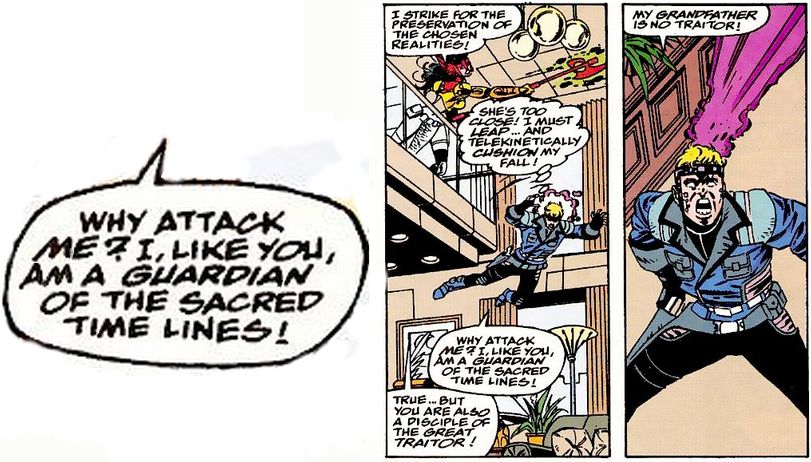
Dr Who and the Future of the Fantastic FourDr Who is very British: it looks forward (it's about time
travel) by looking backward to when Britain had power.
it's about principles, not force. It's rooted in the 1960s
with the police box (once common in British cities), the
Doctor tends to wear old fashioned clothes, ad the
attitude to exploration and fair play is distinctly
Victorian. It harks back to when we had power and
idealizes the best principles of the time: decency and
modesty and invention. As the Great American Novel, the Fantastic Four similarly reflects America. With the rise of China and various growing problems (what they are depends on who you ask), many feel that America's best days are behind it. If so then expect a nostalgia for when America won because it was right, not because it was the most powerful. The Fantastic Four is rooted in America's greatest era: Reed and Ben fought in the war, then the team reached the moon and beyond in the 1960s. The FF, if they return to the original formula, are perfectly suited to be America's Dr Who.
|
The merging storyline (Inferno) ends with FF325, the last issue before Englehart's "John Harkness" issues where Reed and Sue are forced back. The cover to FF325 is a beautiful homage to FF72, from 1968, where the surfer despairs that mankind will ever learn its lessons.
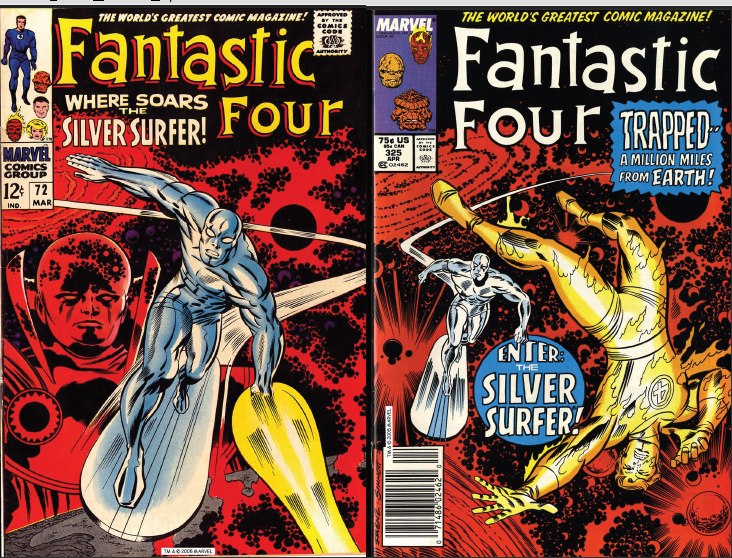
Both issues are about a time when the FF story should have ended happily: when Reed and Sue put Franklin first. In both issues, only the Watcher had the power to ensure that all is well. But in FF325 the Watcher is not on the cover: a rogue watcher is causing the problems and hiding his actions from our Watcher! This time our Watcher can't save us.
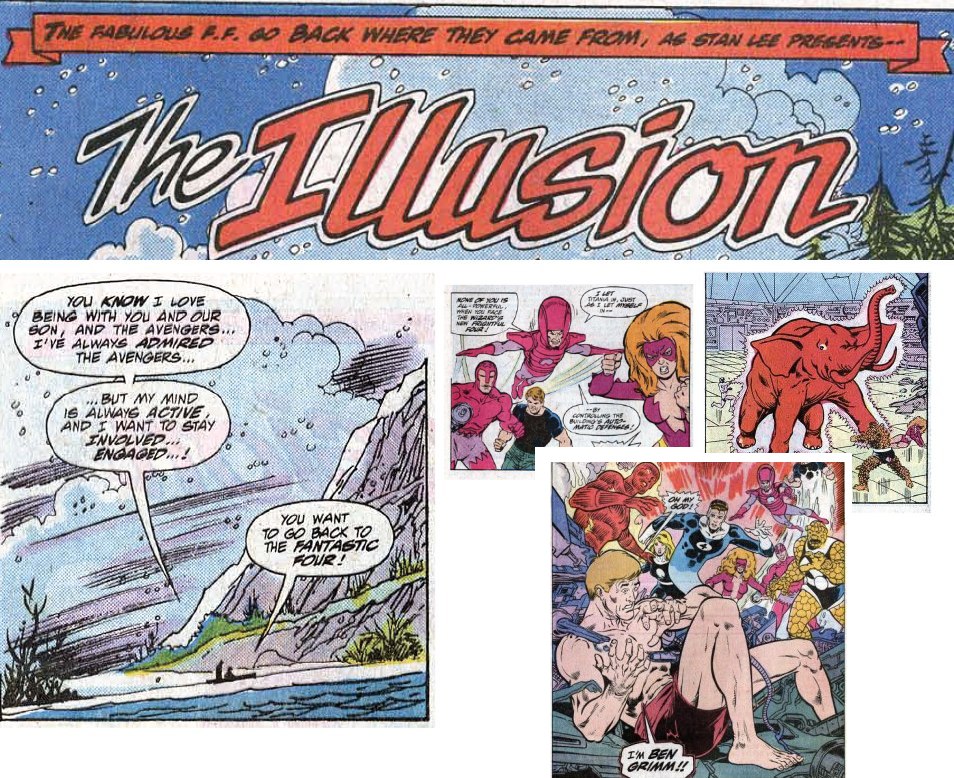
America is finally happy
Reed is relaxed and happy. He said he would be OK even if he lost his
powers: such a contrast with the 1970s! Johnny and Ben are friends
again. Everything is made happy, relaxed and safe, just as a five year
old would like. This reflects the new world of the 1990s. The old
dangers were gone, people were wealthier than ever, and students were
more likely to do their homework than rebel in the streets. Life was
good.
Still the same team, but for how long?
Franklin has done something, but this is still the same team: Reed knows
that he was "doing his bit for world peace" before other heroes were
even born, and Sue knows that they went into space to "beat the
commies". This has not yet been retconned.
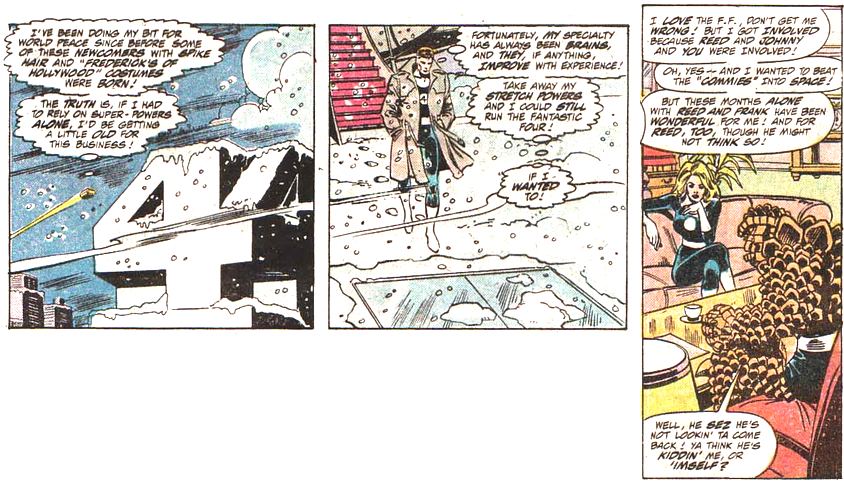
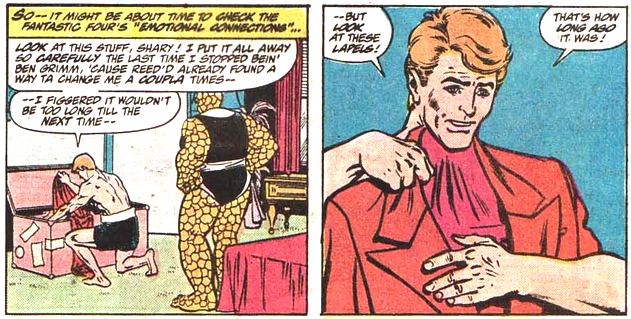
One of our last looks at the old Reed
This issue goes to pains to make clear that this is the original Reed:
he is a genius, but he is still within normal human limits. He is deeply
impressed
by a chip that can show 4096 colors: as we saw in annual 15 and many
times before, Reed is a realistic scientist, and that's why we can
relate to him. This drives the Wizard crazy! He knows that he can do
some things that Reed cannot, and proves it. Obviously the Wizard is
highly biased: Reed does have a first rate brain. But Reed's fans
imagine he is well beyond human ability, and there has never been any
proof of that.
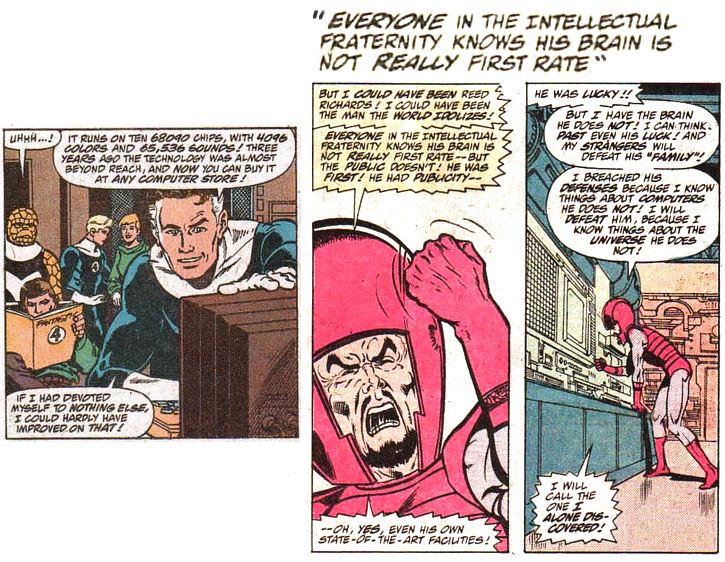
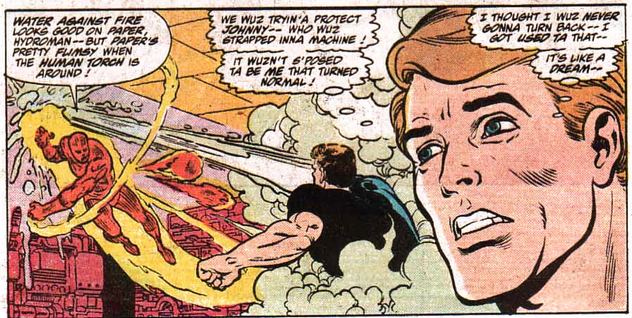
The very next frame has Reed say to the Wizard "in your dreams". The dream motif is strong.
The titles indicate that the dream story begins here. Her are the titles from 326 to the end, 333
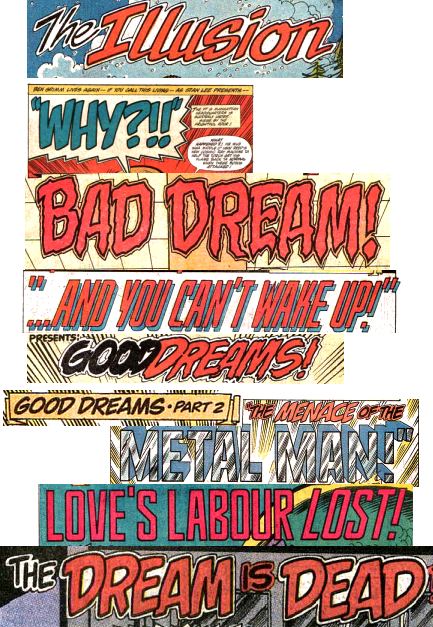
A reminder: how it all happened
Here is a summary of act 5
But how does Franklin do this? The key is the Wizard
The Wizard is often handled as a joke character. But look beneath the
surface: nothing could be further from the truth. Tragic? Yes. A joke?
No: he tells the truth. He really is that smart. He was the first to
decisively defeat the FF (in FF38) and here he defeats them permanently,
by replacing them with the final incarnation of the Frightful Four: the
clones.
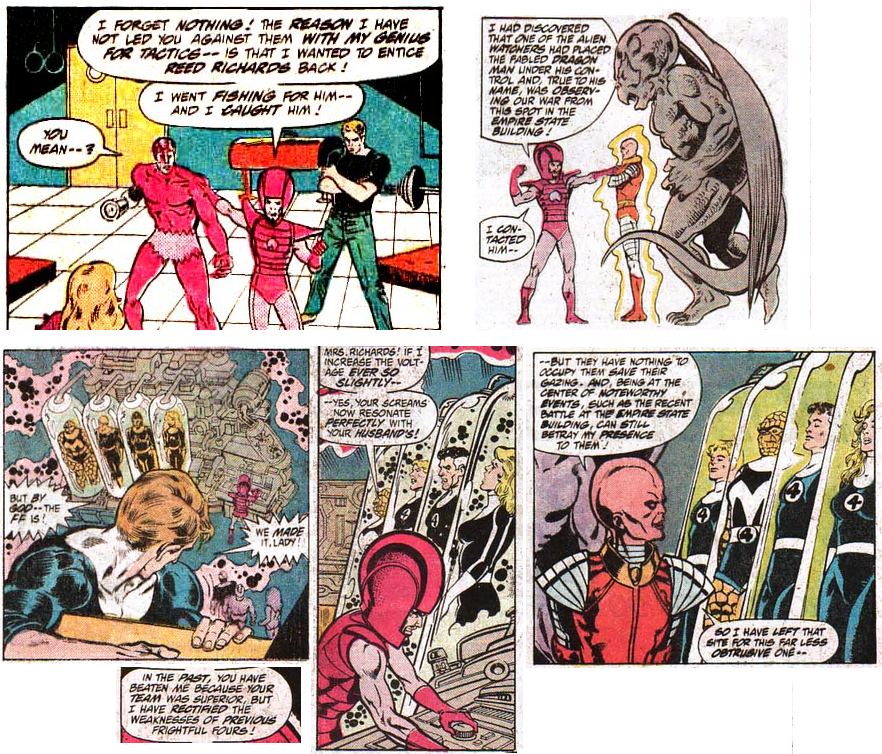
The Wizard planned it all. Just look at the timeline:
What are those clone tubes for?
The tubes are clearly designed to keep the FF from escaping: both the Wizard and Aron use them in that way. But why do they need such a huge bank of machinery? In FF 329 the clone Thing later refers to this as a Doomsday device. If, as I suspect, Aron needs to study the team in order to find a way past The time bubble (the Great Reboot), then "doomsday device" is not far off. Then what does the Wizard mean by torturing? He does not torture for its own sake, but in 301 he showed himself to not care if others suffer in the course of his studies. He seems interested in making Reed and Sue scream in unison. Clearly he is studying them, and torturing them is just how he explains it to others.
The final Frightful Four
All the references to the Frightful Four only make sense if the
Wizard is planning for them to be replaced by the FF themselves.
He states that the FF are the greatest team, and they can escape from
almost anything. Titania
reminds him of this: yet he does not bother killing them, even though he
has
shown his willingness to do so (e.g. in 301). Meanwhile his temporary
team of
Hydroman etc are as useless as ever, yet he treats the FF as no longer a
threat. Judging by his previous behaviour, e.g. in one of his first
appearances (FF 41) and his most recent appearance (FF 301) he
specialises in min control. It seems most likely that he plans to
control the FF's minds: only the FF themselves can defeat the FF. Aron's
plans to clone the team are not what he wanted, but he can adapt: it
has the same result. The FF end up defeating the FF. The final and greatest Frightful Four are the clone team.
Franklin and Aron
Of course,the Wizard is himself being manipulated. Ultimately
Franklin controls this reality, and nobody understand the situation
better than the Watchers and the Watcher's friends the Dragon Riders.
Aron (Ral) is responsible for policing the dimensions, and of course he
knows about Franklin's loss of control and the coming great reboot.
He desperately needs to understand the situation, hence the need to
study the FF's dreams, and particularly a version of the FF that
reflects Franklin's fear of change. That explains Aron's need for the
clones and their dreams, and his willingness to take drastic steps (to
control the world) if it's the only way to fix things. The Wizard's
interest in Franklin's dreams makes the wizard the perfect partner:
acting like a generic villain allows Aron/Ral to change this reality while appearing to be just another part of it.
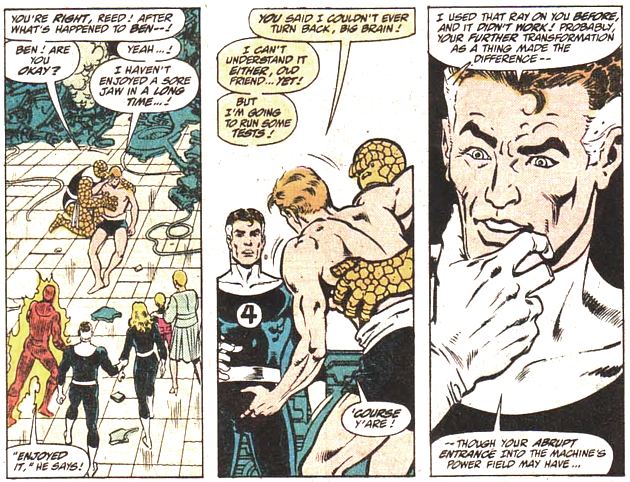
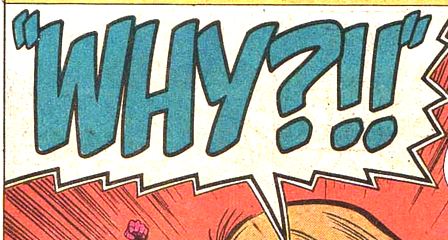
The choice facing Aron is the choice facing America in 1989.
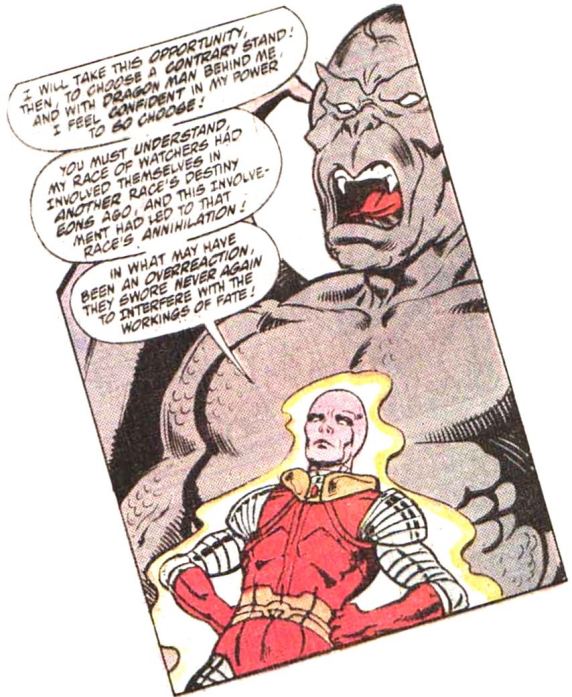
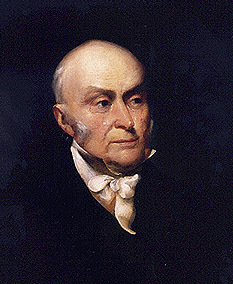
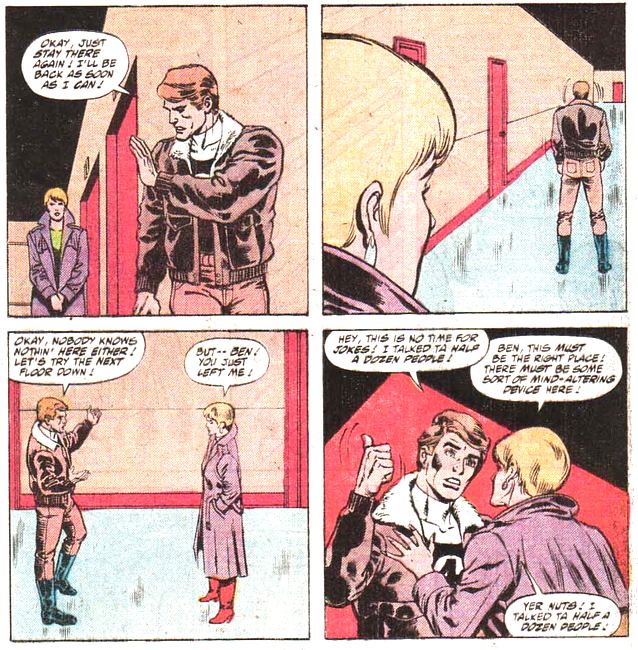
It's still fun!
I admit it, this web site is very "Comic Book Guy:" the new
comics are the Worst Comics Ever, and everything was better when I
was a kid. Well that's true, but it's not the whole story. Some of
the new stories are actually very good. FF328 is superb: it's fun,
it's clever, we see Ben and Alicia save the day, it has lots of
realism (ordinary people, the Empire State Building) and lots of
incredible exploits. It's not far from the
classic formula and it's a lot of fun!
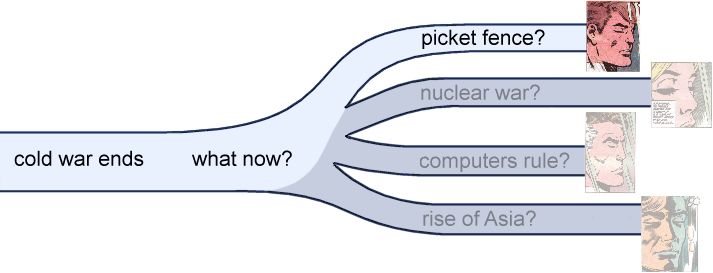
The last four issues show four view of the American Dream four ways
that the story can end. The first is to turn the clock back. Relive the
past. Ironically, we have two versions of this dream: a real one that is
fake, and a dream that is real. The real version is an attempt to live
in the past, and that just won't work. But in Ben and Sharon's dream
they are more realistic: things change and must move on, but they just
want simple things, like friends. This is a simple dream and a healthy
one.
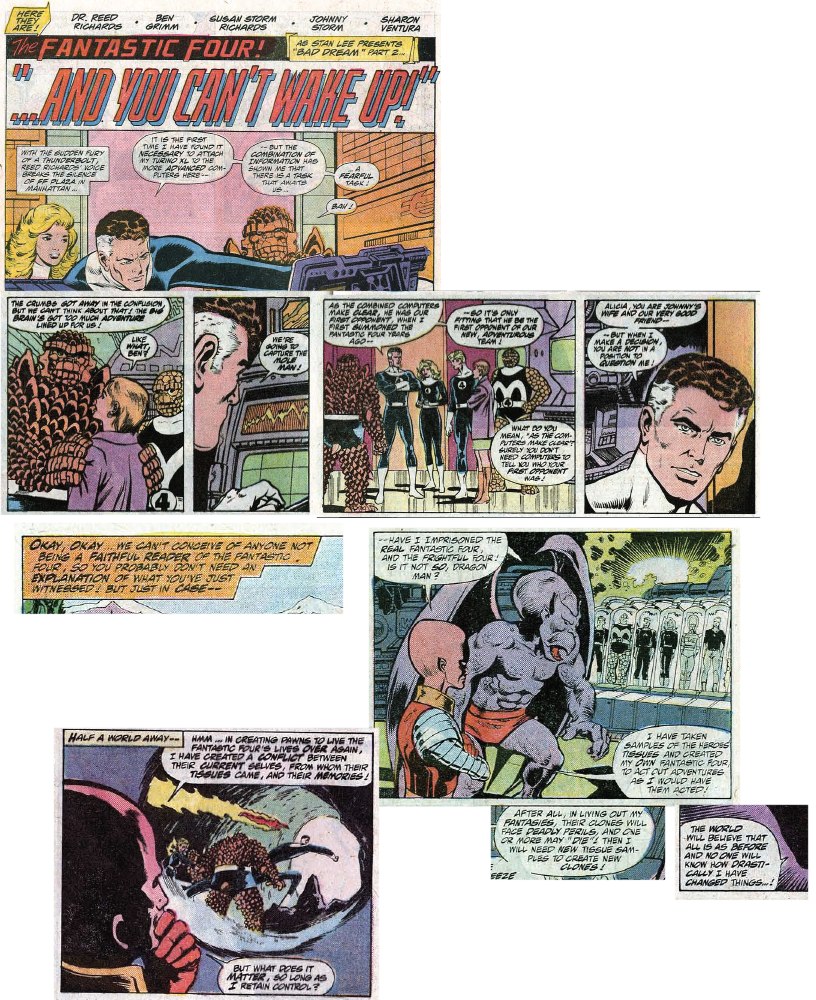
Real world parallels
This is the end of the Reagan era, and critics say his ideas
were a false idea of a golden age. Critics said he tried to turn the
clock back by attacking communists and supporting the religious right
and illusion based economic policies. But supporters say it worked.
Critics reply that it is all an illusion.
A political warning
In the story the Mole Man is ready to be a friend, but the clone team
treat him like an enemy and use excessive force. This can be seen as a
commentary on naive American militarism: while supporter say it led to
Russia backing down, critics say it caused the problem in the first
place, by keeping Russia paranoid. (Stalin for example famously wanted
"socialism on one country" and was justifiably paranoid because enemies
really were out to get him: which does not justify his violence, but
indicates that we maybe had other choices. In other cases, critics point
to American backed coups in central and south America or Iran and
elsewhere: many people in the world feel America is the biggest threat
to world peace. The Fantastic Four does not take sides of course, it
just tells a story where we can see both sides.
A critique of modern Marvel
Here Englehart - sorry, Harkness (his pen name)- parodies the FF, making them
more intense versions of themselves. Notice the almost direct
quotes from FF1. Englehart is saying" "you want me to turn the
clock back? Fine, I'll turn the clock back." But it only makes
sense if the characters abandon realism - real characters
simply would not go backwards like that.
The clones were intended as a condemnation of Marvel's short
sighted policy. Ironically, "Marvel
editorial seemed completely oblivious to this and instead
expressed considerable interest in the clones, even to the point
of planning to give them their own limited series. Laughable,
sure… but the notion the higher ups at Marvel were getting
excited over cold and sarcastic leftovers is indeed a sad
statement on the condition of the house of ideas circa 1989."
(source)
Other points to note:
"No mercy For the Mole Man"
This
is the last of the Mole Man's ten appearances: those who hanker after
the past will always treat him with suspicion. For how the Mole Man's
ten appearances reflect racism and the underground in America, see the
notes to issue 1.


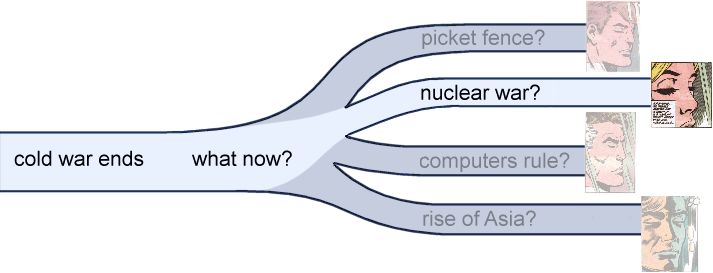
This is the big one. This is Sue's dream: the second of four options.
Sue's intuition is usually right, so this is the "real" ending to the
28 year story. Indeed, to a large extent the Fantastic Four is really
the story of Sue Storm, and this is how her story ends.
And what an ending! It is nothing less than the end of the world.

Sue has always been the one to warn of danger. She is the only one
who sees the madness in conflict. The boys seem happy with continual
conflict, but Sue sees where it must end: sooner or later you find two
sides that are equally powerful and neither one will back down. The only
possible result is that the destruction escalates, and escalates, until
everything is destroyed. Each side grabs the strongest, most
testosterone fueled allies they can find, and the biggest weapons they
can find, and the loser is everybody.
So the great story ends like Dr Strangelove, or like the original Planet of the Apes movies, with nuclear Armageddon.
And even though the Berlin wall is down, the nuclear bombs still
exist. Russian weakness does not led to stability but desperation As
long as people hate and see force as the answer then the weapons will
eventually be used.
This is the natural end to the cold war. It is what everyone expected from the start. Sue was not able to persuade Reed to put Franklin first. He chose fighting instead.
This is the natural end to the Fantastic Four. It began with having
to beat the commies, but what they really had to beat was their own
violent tendencies. And they failed.

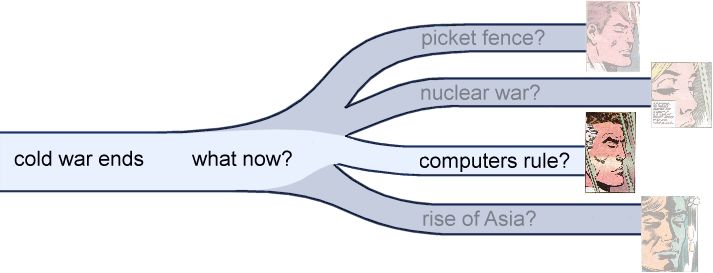
The Great American Novel reflects its present. Nobody can know the future, so it offers a choice. The third choice is that computers will take over. This is quite prophetic: every year we rely on computers a little bit more. This ending may be the most disturbing of all. Although it seems like they have defeated Ultron, in fact he is in every home and business in America: they may defeat one, but there are millions of them, and they learn. The battle is already lost.
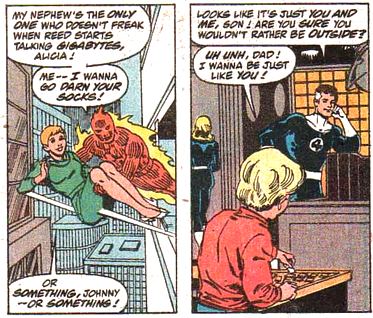
But in the real world the computers have no need to destroy us: they just need s to serve them. Reed is happy to spend his life working on computers, and so is Franklin. So they are slaves to computers but they are happy. This is the first time that Reed has connected with Franklin on a deep level. The computers may now rule, but at last the humans are happy. For more about the rise of machines see the notes to FF212.
The Fantasti-tax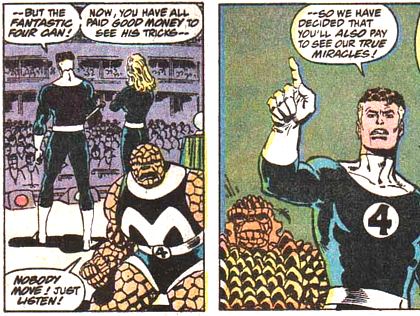
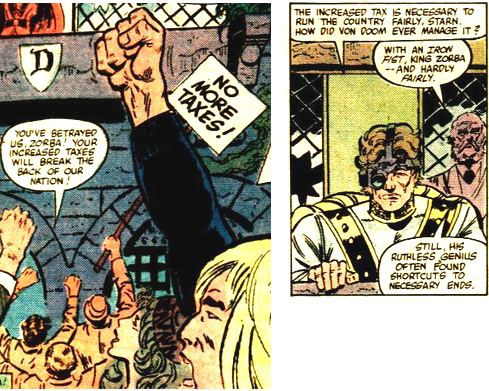
Englehart has some fun
Yeah, I admit it. I'm an unrepentant Englehart fan. His run is my second
favorite after Lee-Kirby (if you don't count those glorious but far too
infrequent Perez issues). This is one of
my all-time favorite issues. Ultron takes advantage of the computer
revolution to put himself in every home (and this is 6 years before
Windows 95!), the Ben and Sharon relationship evolves, the world
blows up (in the previous issue), Ben shows his stubbornness in a
comical moment, and the ending is based on a bit of realism the
reader should have spotted but didn't expect. It's just great fun.
But more than that, Sharon becomes just as good as the Thing was in
his early days, cements her place at the middle of the team, and the
ending is superb. There's even a nod to the early FF (Ben did that
kind of squashing trick a few times in the early days): Englehart
shows how to really be like the early FF, without going backwards.
But that's all a dream sequence. Englehart was not allowed to really
do those great stories.
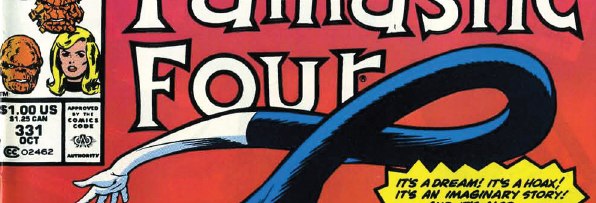
That cover line is a classic: "it's a dream! it's a hoax! It's an imaginary story!" It harks back to earlier DC comics where nothing ever changed, so they tried to persuade readers that "no, this story matters, honest."
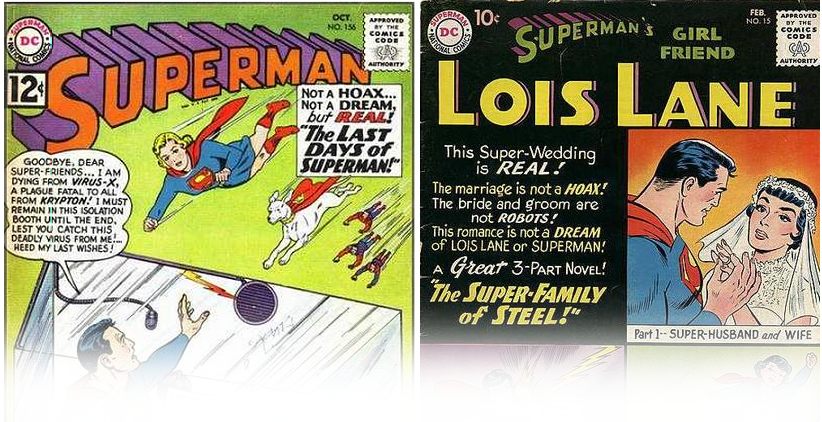
The Franklinverse is like that. Marvel tries to insist that every
story matters, but long time readers can see through it. The only
interesting part is Franklin, because he exists across all the
dimensions, and to some extent what we see is because of him.
The title, "Beware the Metal Man"
All the titles after the inferno event (i.e. 326 to 333) refer to the
end of continuity and a slide into a backward looking inferior dream
state. "Beware the Metal Man" It probably refers to an obsession with
looking backward to the silver
age.It does so in two ways:
I asked Steve Englehart about this theory, and he says he actually
took a break from symbolic titles this month. At least, that was his
intention. But this web site is not about intentions, it is about what
is on the page, even if its cause was accidental. The
"silver age" theory enables us to have a nice simple theory that
explains every title in this period, so it is the easiest way to think
of them.
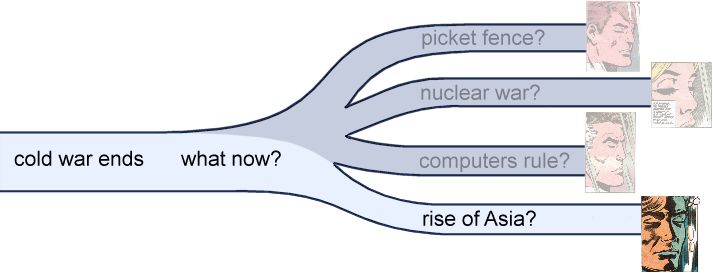
Johnny's dream is, naturally, about Crystal. As I've mentioned
before, the exotic Inhumans, originally from the Himalayas, are Asian.
Their martial arts and ancient society based on strong respect for the
family just reinforces the fact. So when and Asian becomes part of the
FF it can be seen as representing Chinese, Japanese, etc., becoming part
of America. This was a major trend by the end of the cold war: Asia was
not conquering America through war but through friendship: through
trade. Reed welcomes Crystal: she brings talents that the team needs.
But Sue sees Crystal as likely to replace Alicia: literally taking her
job.
.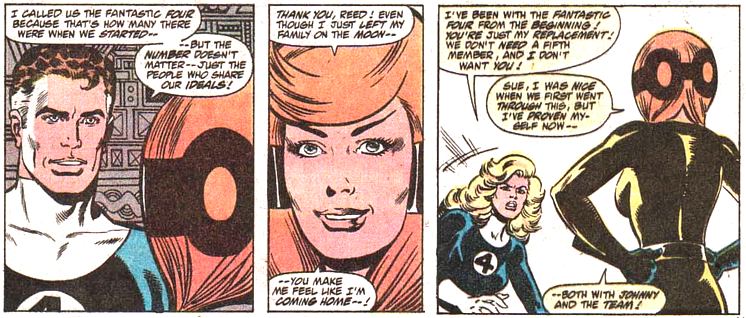
This is not racism but a simple fact: the Inhumans are very powerful: two of them have already replaced parts of the Fantastic Four at times. They could easily become a permanent part and change the character of the team forever, just as east Asian economies become a large part of the American economy. Some see this as a bad thing, most economists see it as a good thing (because we only trade if it helps us), But either way, it is the future: there cannot be another cold war if our potential enemies are part of us.
Three love triangles
Why is Sue so worried about Johnny's marriage? Because she knows how
hard a love triangle can be. Sue, Ben and Johnny each have a
friend with whom they have shared passion, who has helped them through
their darkest times, yet they should not marry. But once married that
makes things so much harder.
Johnny's family
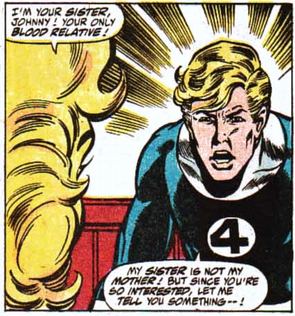
Franklin explains the Franklinverse
This issue finally begins to introduce the Franklinverse: the fact that
Franklin has been controlling everything. At first we just see how he
controlled the FF, but in later years we will see that his influence can
be far greater. Mostly Franklin's
control is unconscious, but in FF322 is where Franklin begins to feel
guilty and talk about interfering.
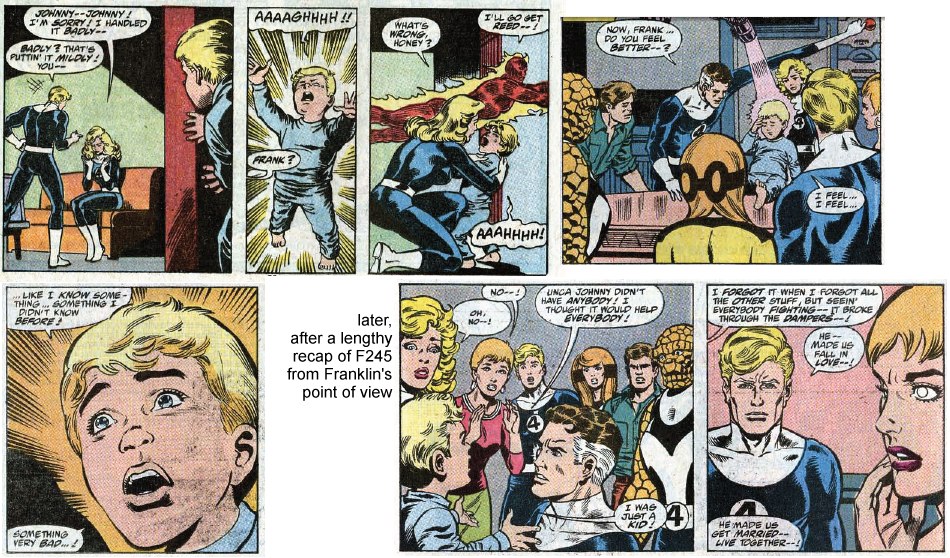
Note that he did not actually control Alicia's or Johnny's mind.
He only used his powers to give Frankie (Johnny's old girlfriend) and
Ben what they already wanted. This led to a romantic vacuum where Alicia
and Johnny were an obvious match, and Franklin would have simply
pointed that out. For details see the discussion by FF269 (especially regarding Franklin) and FF270.
Other points to note
This is the last issue of the Great American Novel. The story has been told, and it has reached a dramatic ending. Where now?
The future will be decided by our children. And the whole 28 year
story is embodied by a child, Franklin (and whether Reed would put him
first). So let's look at Franklin's point of view.
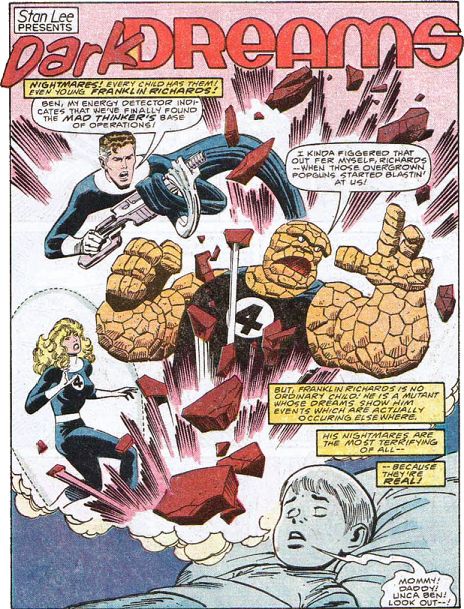
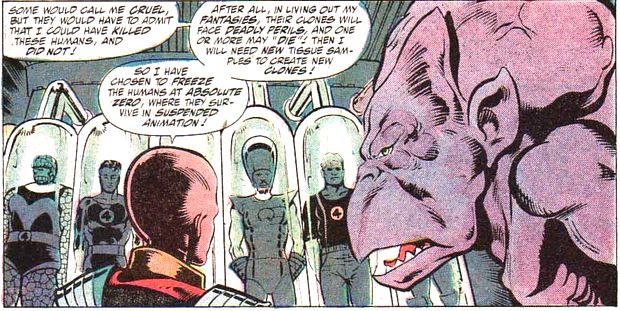
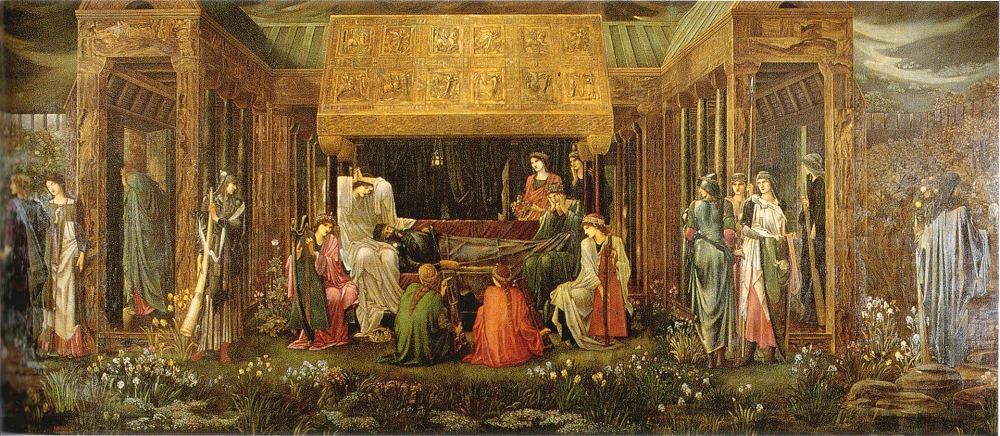
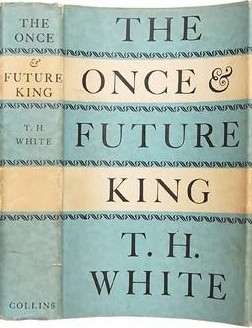
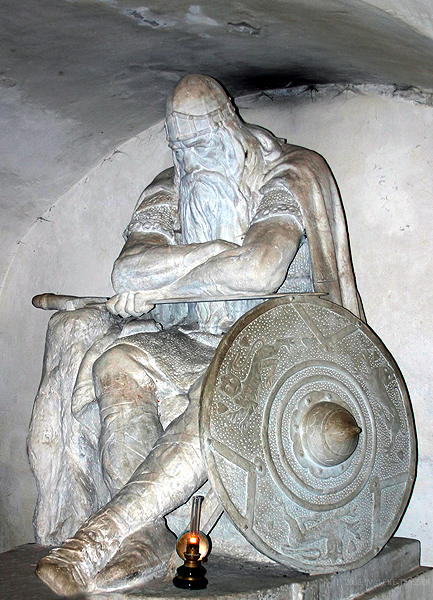
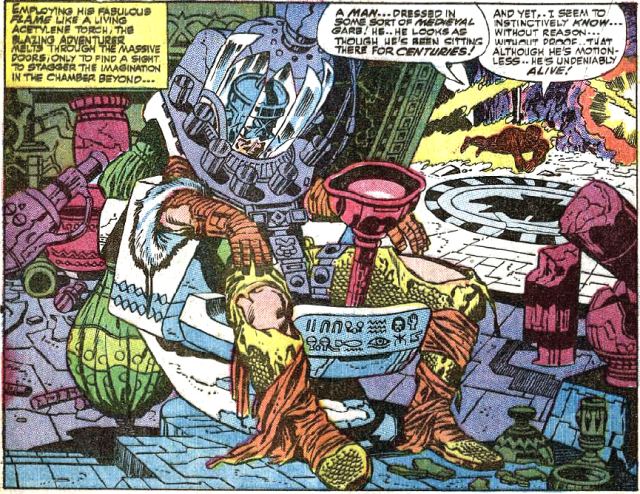
So the FF at the end of act 5 are part of a long tradition of great heroes.
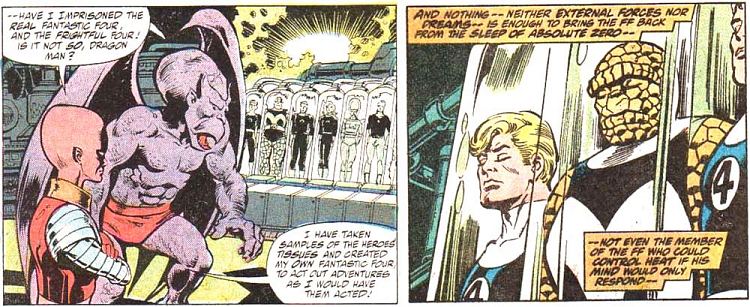
In this issue they do awake, but where do they go? Aron has the power
to do what he wants: does he freeze them again? Send them far away? Or
do they return? Let's see.
At the end, Aron says he will freeze the clones and watch their dreams instead.
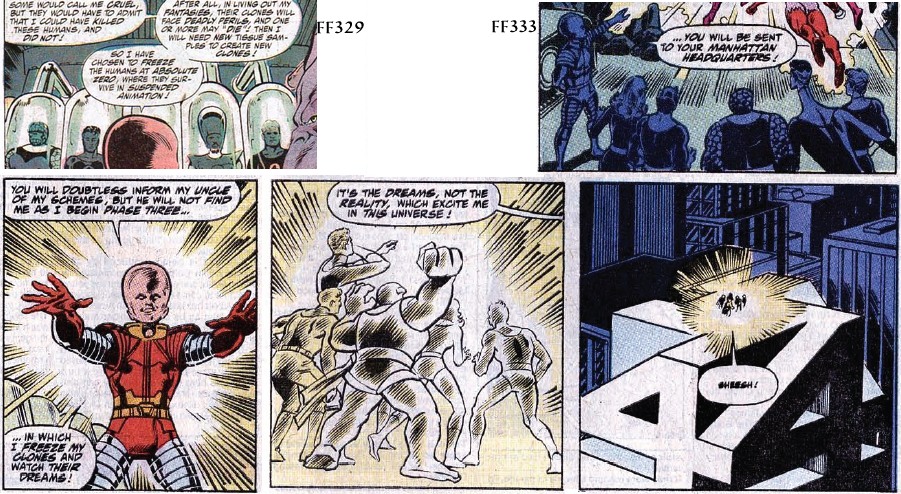
We then see a team who believe they are the original. Is this really the original, or is this the new team, dreaming?
This last issue is about the difference between the real team, which changes, and the clone team, which tries to stay the same. Steve Englehart wrote this issue as a clear and deliberate warning of what was happening at Marvel: we were beginning to follow clones, not the original team. Let's see if he was right.
The original Fantastic Four ends here
The last page of Englehart's last issue (FF333) says it straight. The
next issue will be a new beginning. Let us be very clear: the previous
Fantastic Four was over. A new Fantastic Four was beginning.
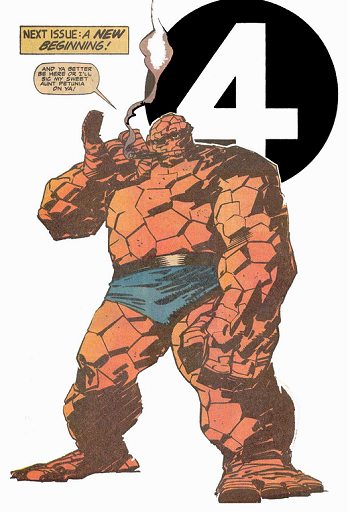
The phrase "a new beginning" was used only one other time: at the
very end of Stan Lee's run, in a small note on the last panel of FF 125.
That was a historic moment, the end of the original era, yet only
warranted a small part of one small panel. The end of Englehart's run
warranted an entire page, and multiple stories about the end of
continuity. The end of Englehart's run was a far bigger deal than the end of Stan Lee's.
"A new beginning": the clone team mantra
The clone team was all about a new beginning. About going back to the
start, to what is familiar. How could they make it any clearer? Marvel
cannot say these
are the clones, because they would lose readers. So they say "these are
the original Fantastic Four" - who just happen to be just like the
clones. and different from the team you saw until FF 333. "Move along.
Nothing to see here."
Other Marvel characters were also replaced
This was the year 1991 when many of Marvel's biggest characters were
replaced: this was the "end of the Marvel Universe" that Jim Shooter
famously mentioned to Doug Moench. For more details see the page on the Marvel Universe.).
Spider-Man was replaced by a clone as well. Iron Man was replaced by a
nineteen year old. Wolverine, who had spent years learning restraint
and honor, became a bone-clawed feral version. Walt Simonson who would
take over the FF, had just shown Thor replaced by Beta Ray Bill.
Everyone was changing or being replaced, and only in years later was it
decided wether or not to retcon whether the clones were "real" or not.
E.g. the clone Spider-Man was so unpopular that it was decided to be the
real Spider-Man all along... or something. Nobody could keep it
straight any more.
A different team
From now on, we follow a different team.
Officially they were the same, but this web site is about what the
comics actually show, not what was intended. The comics show a
completely different team, no matter how much we might deny it. In
truth, even the fans admit it: ask any hard core fan and they will
accept that the past is new routinely changed due to the sliding time scale.
You say the past has changed, I say the characters have changed. We use
different words but we describe the same thing. A person with a
different past is a different person.
The team still sees itself as real
Of course, the team itself saw itself as real. Ironically it sees itself
as more real because it tries to be more like the past. Many fans want
this: they do not want their
characters to change. Englehart's final issue was all about that
question: which is the real team, the one that changes or the one that
stays the same? (The clone team was more powerful, and was only defeated
when the Wizard turned against them. This was the Wizard's final
redemption, as we'll look at later.)
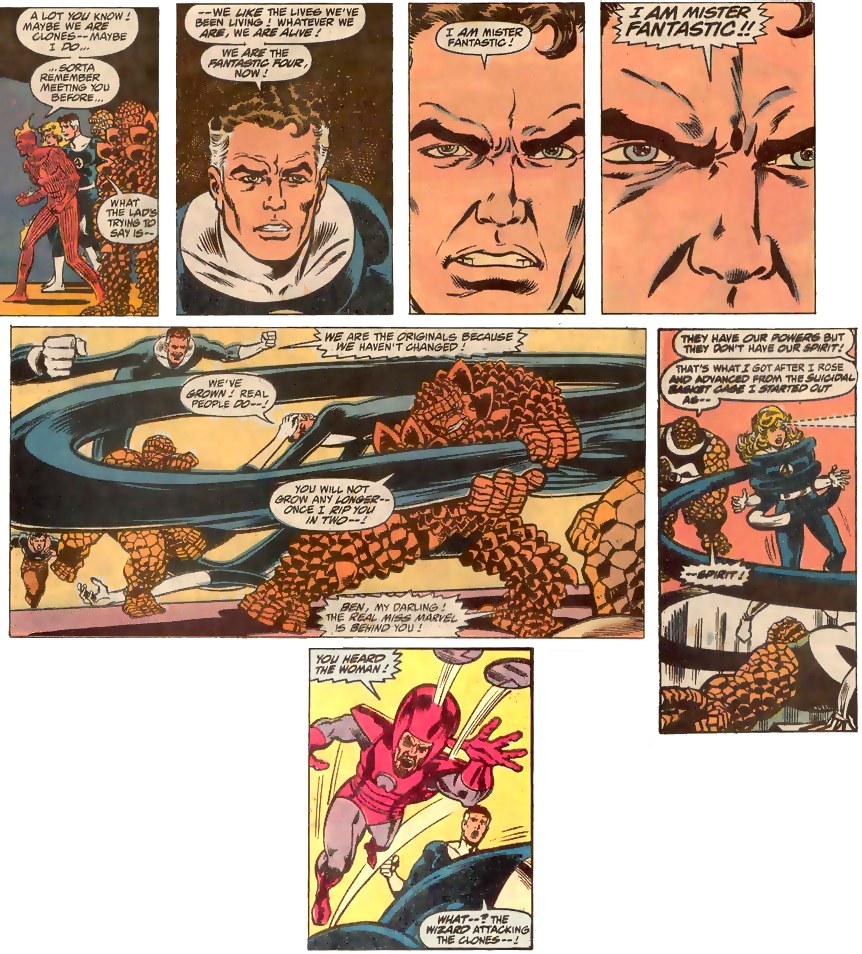
The debate continues today
Issue 333 crystalizes the debate that continues today: which is the real
team? The one that does not change, or the one that changes? Jack Kirby
was very clear on that matter: every artist and writer must follow
their own vision, and not try to copy somebody else. It is impossible to
do something "in the style of Jack Kirby" because the style fo Jack
Kirby is to do something completely new. Even by the end of his run,
Kirby was changing the FF. They were often seen in civilian clothes,
Reed and Sue wanted to leave to take care of Franklin, Crystal was a
central part of the team, and Johnny was grown up. This web site stands
firmly with Jack Kirby's vision: a team that grows and develops. But
most modern comic fans actually prefer the unchanging team, because most
fans who want change stopped buying superhero comics a long time ago.
The clone team is real
It
is probably not fair to call the clones fakes. What if you were a clone,
how would you feel? You would be real! In the real world, identical
twins are clones: they share the same DNA. But they are both real. So
there is nothing wrong with enjoying the new Fantastic Four stories:
they are real as well, even though they are the dreams of clones.
We should not worry about a clone being "less real". Scientifically, a
clone is just somebody with the same DNA, but their thoughts and
experiences are unique. We all share DNA with our parents, so that is no
big deal. And as for being a "copy", isn't the Human Torch a "copy" of
the original Human Torch? Wasn't the Invisible Girl a "copy" of the idea
of H. G. Wells' Invisible Man? And The Thing was only one of many
"Things" on sale the same month as Fantastic Four 1 came out, and
Mr Fantastic was like Plastic Man, and so on. We are all copies, so that
should not bother or offend us. As soon as a copy is made it begins to
experience a different life and becomes its own original.
Clone dreams and the Franklinverse
"Aron" said he would be following the clone team's dreams. But as we
know from "Tales of the Watcher" and the Watcher's "What If", all
possible realities exist out there somewhere. So a dream is just a
parallel reality: to that reality they are the real people and we are
the alternate or dream world. Franklin relies on this fact: almost
anything he can imagine can become real because he moves between
dimensions. We just saw this in issue 332: the real team's "dream" was
the genuine stories that writer Steve Englehart had intended. They were
the real story, but in our reality we had to see them just as dreams. For more details of how Franklin's power works, see his own page, and the discussion near the end of the last page of this site.
On the next pages we will discuss the Franklinverse in more detail, but don't get hung up on the difference between dream and reality, clones and original teams. They are all merely expressions of Jack Kirby's original purpose for the team: what might happen?
The clone team are bad? E.g. attacking the Mole Man
In FF 1 the team do not try to reason with the Mole Man, they just
assume he must be evil: so the clone team are just like the original
team.
They are all murderers?
In FF 329 Sharon says: if Alicia understands what's happened here "we'll
have to kill her". Ben says he'll do it himself. Aron, when in Limbo,
said he would destroy the FF. So are they all murderers? Not if this is a
dream. Later in the issue Reed says "only power greater than ours can
waken us". This is one of numerous references to being in a dream, or a
dream-like state. In FF 291 we learned that death in any dream-like
state just means waking up. Sharon is smart: she realises there is
something dream like, but also that it is important to go along with it.
So if Alicia causes problems she will have to be killed in the dream in
order to wake her up in the real world. We have plenty of proof in
later years that "death" in the Franklinverse means nothing. If a
character dies they just come back a few months later.
The fantasti-tax
The tax shows them to be just like the original team, but lacking
experience. The original
team stood out because it was more realistic. Since the people of New
York want to be saved, and that incurs serious costs, it is reasonable
to ask for payment. Of course it is also a colossally bad idea because
it breeds corruption, but the clone team lacks experience so they do not
realise. But they soon learn their lesson when they are defeated by the
more experienced team: they won't try a tax again!
The clone team fight the real team
Each team believes it is the real one, so the clone team is being no
worse than the "real" team. Their rough manner can just be put down to
arrogance - at this point they think they are unbeatable. They just need
a good defeat to learn humility.
Ben acts especially angry and cold
Ben is angry, like he was in FF 1 through 7. But here he is more
angry because Reed has changed him into his rocky form for no good
reason (as explained at the start of FF329). So why doesn't he say
something? Because this Reed is so powerful that there is nothing Ben
can do.
Anybody who can change your body in seconds is not somebody you want to
mess with. All Ben can do is be passive aggressive. You would be too!
But in 333
Reed changes Ben back to human form and this calms him down.
At the end of FF 333 Ben is in his ordinary human form.
This is easily explained by referring to the start of FF 329. Clone Reed
is so clever he can very quickly and effortlessly change Ben's form, by
using rays from the tube machine. There are plenty of rays around just
before Ben changes back.
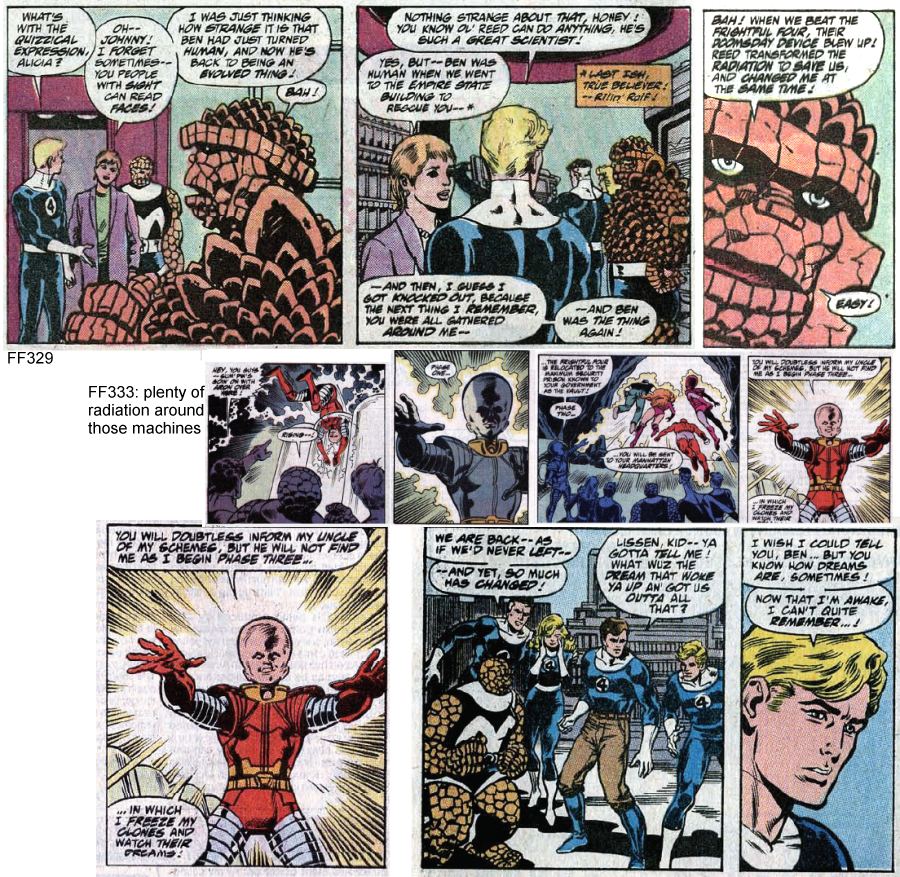
If Reed can change Ben easily, why doesn't he do it again?
The clone team were reliving the very earliest adventures. In those, Be n
could easily change due to radiation (e.g. when returning in the Skrull
craft in FF 2, or on the beach in FF 9). That period of easy changing
soon passed.
Why doesn't Ben say something more?
Ben states in FF334 that he says what he does in a calculated way to get
the desired result from Reed. Ben is not speaking his mind.
"But it sure looks like the real team"
On the last page of 334 the team admit that people will think they are
the clone team. This is a big problem. If they are the clone team (as
all the other evidence suggests) then they would go to extraordinary
lengths to pretend the opposite, at least in the first few days. Ben is
the biggest difference: the clone Ben was rocky and angry, but could
easily change without much explanation (see FF329). This Ben has changed
and makes sure he spends time in public places (a movie theater,
shopping, walking down the street). In a few issues (FF354) he will
change one more, again without any real explanation. His "bah" stage is
behind him though, just as the original Ben mellowed after the first few
issues.
But they don't act like the clones did!
The clone team share the real team's DNA and memories. They were just
young an d inexperienced at first. They soon matured into a comic title
worth reading:
.
The clones are more powerful
The first thing we learned about the
clones was their greater power. This is the topic of the first three
issues (334-336): villains that were major threats to other super
powered heroes are no threat at all to this new more powerful team.
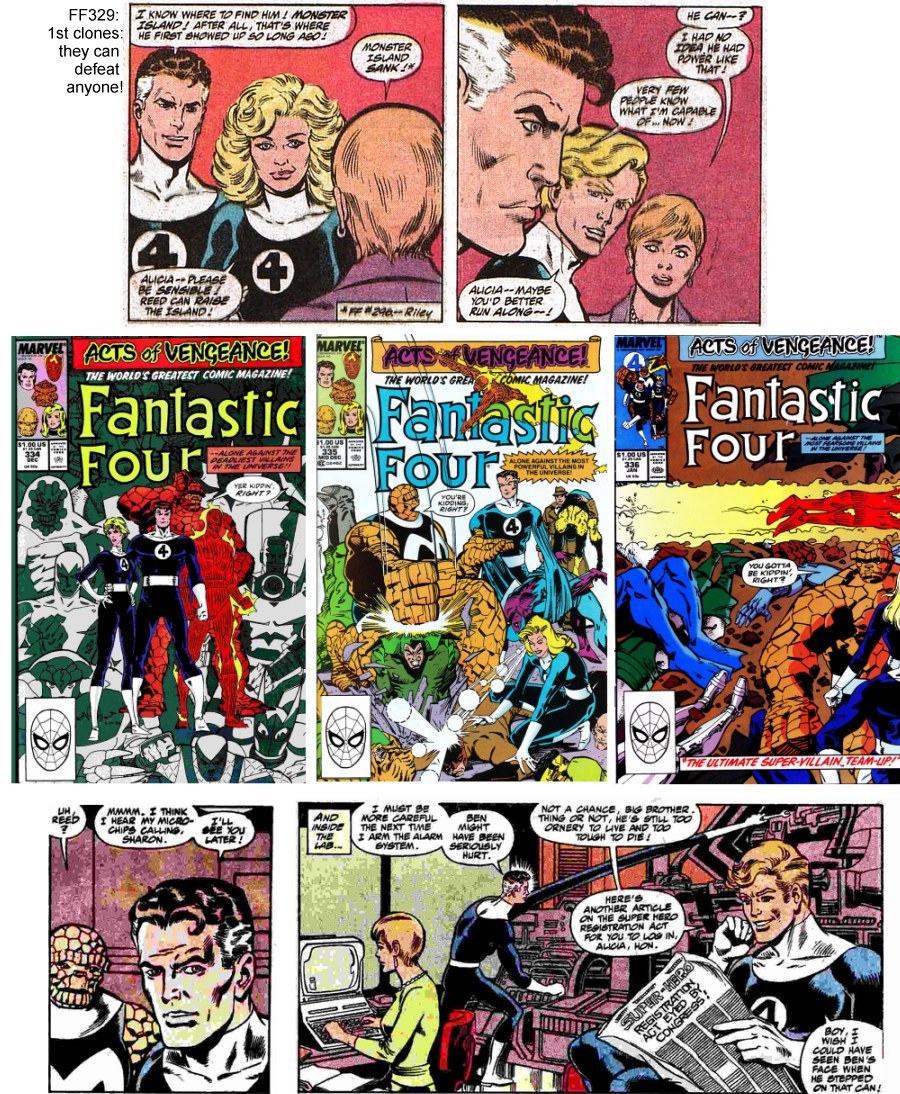
The clone team also talks in an awkward way, as in the above frames
from 334. Note that FF334 begin with the team studying the politics for
"weeks". They are no longer quite so new and inexperienced and have learned the lesson of the Fantastic-tax.
FF 337: Confidence returns
The
defining feature of the clone team (besides never moving forwards) was
Reed's ability to do anything, with almost no preparation. We see this
at its greatest in FF 337. It took
the original Reed years to create a Radical Cube, and we saw in FF 319
that advanced alien races are not able to improve on it. But clone Reed,
in this dream-like world, can create a "radical
dodecahedron" in no time! It's beyond anything even Tony Stark could
imagine.
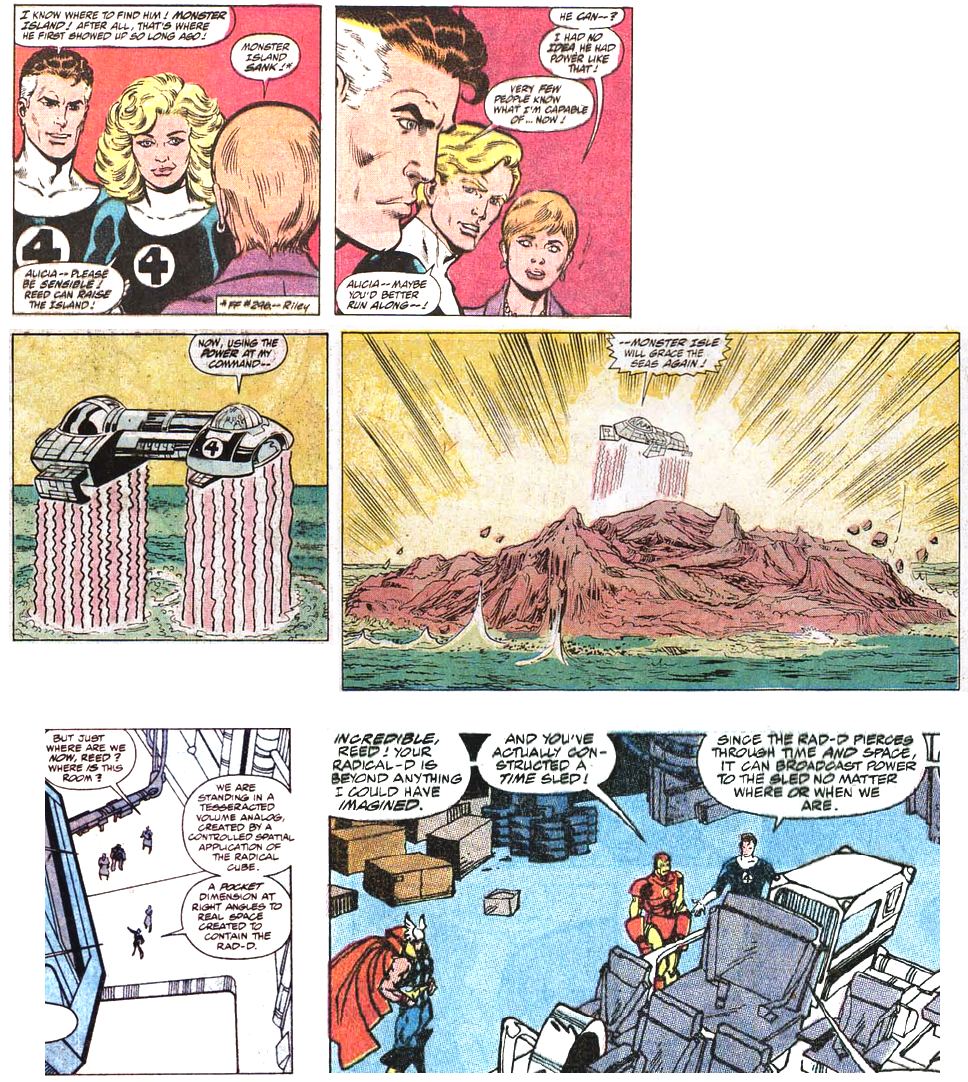
Contrast Clone Reed's "I can do anything" with the very modest abilities of the original Reed in FF 326, where he is genuinely impressed by a computer that can display 65k colors.
FF343: more proof
After 342, a fill-in issue, the next arc begins with another reminder
that this is the clone team: clone Reed has not yet created a washing
machine or robot housekeeper, but the original Reed did that years ago.
This example and more, see the page on differences.
FF 343 continues by showing that the clone team is still stuck in the
cold war. I could keep on giving more and more examples of differences
between the original and the clones, but in general, the biggest
differences are (1) the refusal to move forward, and (2) a focus on
power. Let's look at the subject of power next
Power versus democracy
The original team was interested in democracy. The clone team was
most interested in power. Their defeat in 333 left them very unpopular
with the government, due to the Fantasti-tax. to them feeling
vulnerable. So when registration
was suggested in FF334 they of course opposed it. But soon the
Fantasti-tax was forgotten (they persuaded everybody that they were not
the clones). So when registration was suggested again in the 2000s, this
time Reed supported it.
This obsession with power reflects the national zeitgeist.
The old zeitgeist: democracy
In the cold war and before, America was not the only super power, It
was under real threat, and differentiated itself by its appeal to
democracy: the power of the ordinary person, against those who would try
to rule them. See the notes to FF2, or the large number of would-be
monarchs in the early days (Doom, Molecule man, Namor, Super Skrull, and
many others)
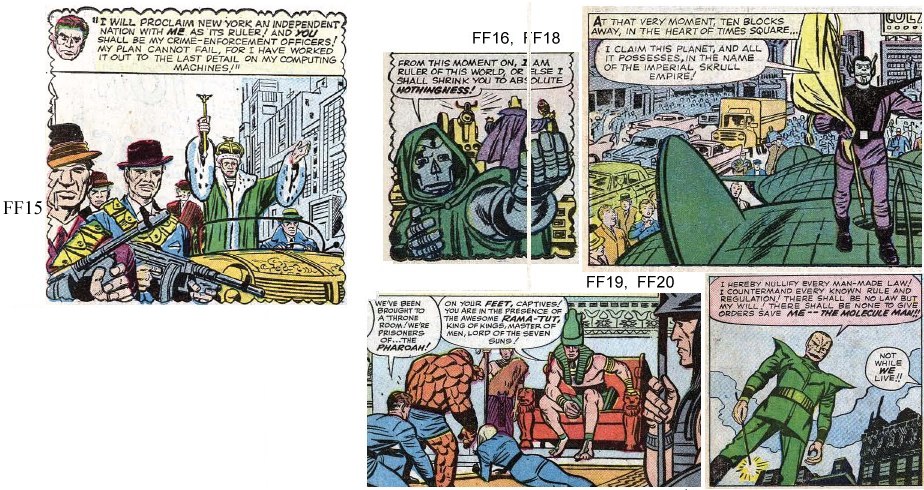
The new zeitgeist: power
From 1989, with the end of the Cold War, America no longer had any
serious challengers: its defining feature now was the world's only
superpower. This new confidence was reflected in more stories about
characters with raw power, and fewer stories about characters as
underdogs. In the past Marvel advertised excitement, now it advertised
power, as in this ad from the 1980s: this ad was the back cover of the
second Superman-Spider-Man team up, so was designed for the widest
possible audience.

The obsession with power reached its peak with Image Comics in the early 1990s. The look (giant guns, harsh faces) was
parodied on the cover of FF343 from 1990:
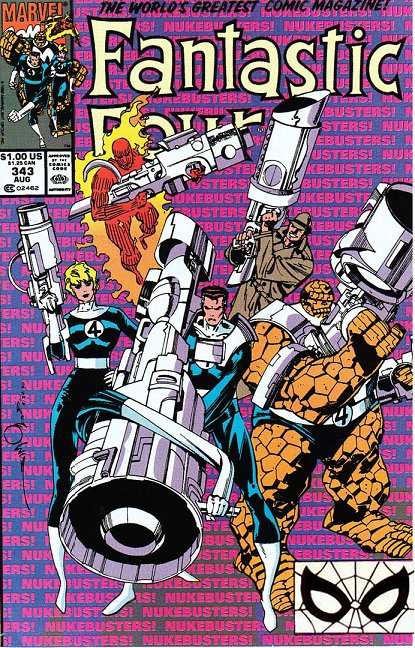
Please remember that the clone team shares the minds of the original
team: they are not evil. But they make sure they accumulate lots and
lots of wealth
Superheroes as ruling elite
Open any early FF comic and contrast it with any FF comic from the
past five years: the first thing that jumps out is the wealth. The
modern team lives in its penthouse, with gigantic slick machines,
(unlike the machines of the 1960s that looked home made), and all the
trappings of extreme wealth; multiple vehicles, multiple costumes,
friends in high places, etc. In the latest arc for example (the current
issue is number 3 in the 2014 reboot) the Baxter Building looks decades
ahead of anything a mortal could afford, Sue Storm
rules her own nation and runs a school where they take field trips that
would cost millions, Johnny can just walk into a celebrity job, Reed can
talk to the head of Shield any time he wants, and Ben (since a previous
story arc) is a billionaire. A far cry from issue 9, or even he 220s,
where they had to walk or take the subway in order to save money. The
modern wealth is exactly what we would expect from the clone team
with their fantasti-tax. But modern corporations do not need taxes:
they use modern patent laws instead. The modern team clearly clone
clearly squeeze their patents for every penny they can. Colin Smith, in
his final entries to his blog "Too Busy Thinking about My Comics" discusses this change at length:
"Marvel Comics [in the past] always
seemed to me to be concerned with stories of folks who found it
impossible, by chance or design or a mixture of the two, to either rule
or serve the powerful of this world and those beyond it. Even Prince
Thor was continually being banished from Asgard for the crime of trying
to think for himself and act according to his conscience. But
now Marvel Comics seem to be about a power elite, who for all their
noble sacrifices and willingness to serve, are beginning to constitute a
class utterly separate from the typical woman and man of the MU. It's
not just that these costume-wearing folks share their life in the
company of others like them, but that they're now assuming positions of
authority within the state too." (source)
"By contrast with today’s version
of the team, and their allies in the world army that’s the 21st
century's Avengers, the FF were revolutionary in effect if not intent.
Whereas the top ranks of today’s super-people in the Marvel Universe
clearly constitute a ruling class – as we’ve discussed before – the
Fantastic Four expressed the confusions and frustrations of far less
powerful social groups. If Hickman’s FF and Bendis’ Avengers have often
been profoundly conservative in the values they express, then Kirby and
Lee’s opening blast on the Fantastic Four was anything but. That the
meaning of surface and sub-text were so often in direct opposition to
each other in that first year was essential to the comic’s vitality and
importance." (source)
The elite and inequality in modern America
This reflects trends in American history. For the generation
after the War, inequality reduced: while the rich got richer, the poor
got richer even faster. But by the end of the cold war this process
reversed. Much has been written about the increasing inequality in
America, where the top one percent control far more resources than the
other 99 percent combined. It is very clear on what side the heroes
fall.
This was all predicted and mocked by Englehart in his final issues.
The cloned team, forever repeating old stories, ensured their elite
status by charging a "fantasti-tax". This reflects the real world where,
although only governments directly tax the ordinary people,
anybody with power can influence government through lobbying. Inequality
is the defining theme of our age.
Dr Strange notices time dilation
The biggest difference between the dreams and reality is the passage
of time. In a dream time does not flow normally. Most people do not
realize, but some of them have a deep understanding of dreams and they
know. Take Stephen Strange for example. In this panel from the issue Dr
Strange hints that time has slowed down. Note his words "longer, even,
than a
calendar would show" - he knows that personal and absolute calendars
are misaligned, and he wants to talk to Franklin. These are the
final frames by Steve Englehart before he left Marvel, where
Franklin asks him to fix things, and Englehart (as Harkness) says he
cannot.
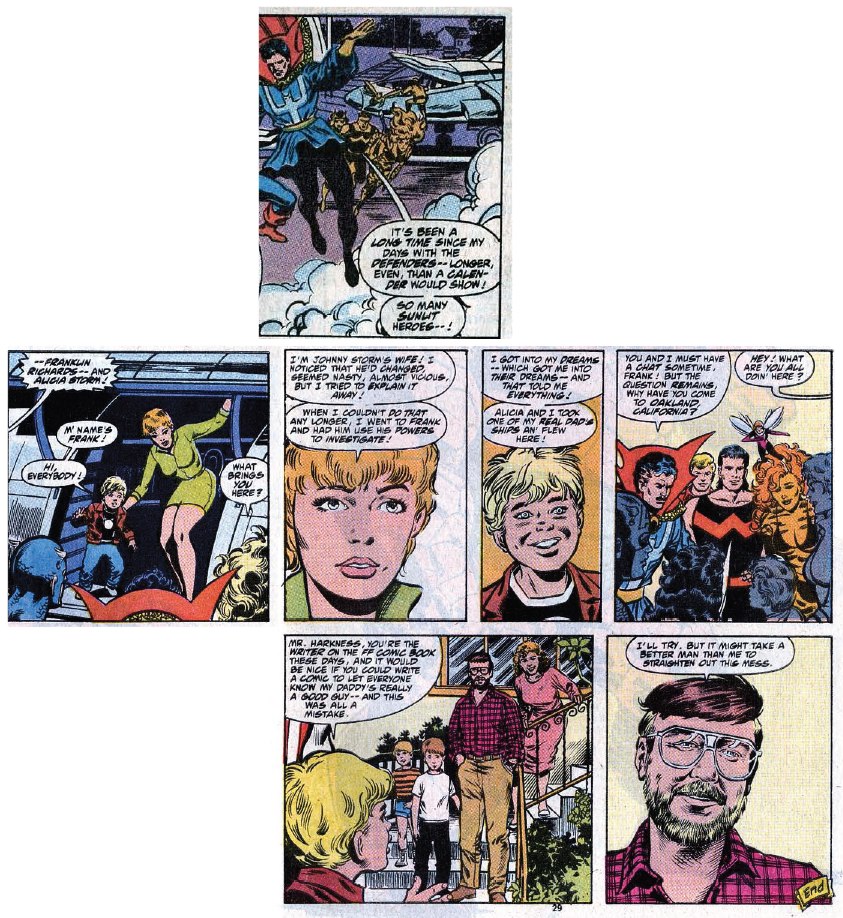
In 1989, She-Hulk reveals how time dilation
works
Dr Strange was not the only character to notice time stretching.
In 1989 She-Hulk noticed as well. She regularly broke the fourth
wall, knowing that she was in a comic nd that Marvel did not
always report accurately. A major subplot featured Louise Mason,
elderly lady and former golden age superhero. She knew that being
close to superheroes would cause her to de-age. The
Marvel Wiki summarizes "Sensational She Hulk" issue 4
(August 1989):
"Wheezi
[Louise MAson, formerly the golden age hero Blonde Phantom] then asks Jennifer how old she is;
Jen tells her she is 31. Weezi says that as long as Jen is in
the comics, she'll always be 31. However, she and Mark weren't
in comics anymore, so they started to age like normal people.
Then, one day the old heroes, like Namor and Captain America,
started to return. She and Mark were sure that it wouldn't be
long until it was their turn again. Unfortunately, it didn't
happen--and Mark died. When he died, Weezi decided that she had
to do something--so she used Mark's city hall connections to get
herself a job with D.A. Tower, so that she would be in a
position to recommend Jennifer for a job. That way she could
appear as a supporting character in She-Hulk's series, and stop
aging."
Why She-Hulk?
She-Hulk was a member of the Fantastic Four at the end of Act 4,
so Franklin knew her well. She is psychologically highly stable
(in contrast to her cousin Bruce, or the Fantastic Four at the
time), mentally able to cope with any dilemma (she's a
lawyer), and can age 180 years without her body
declining (see FF293). So Franklin sees no need to stop her
from noticing the time dilation.
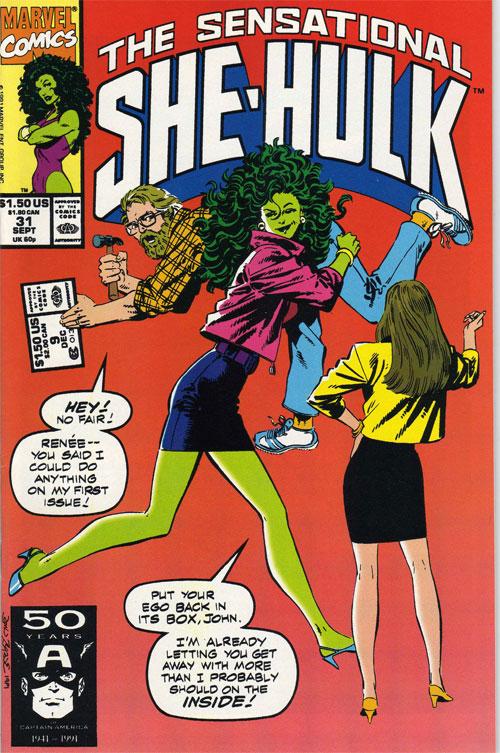
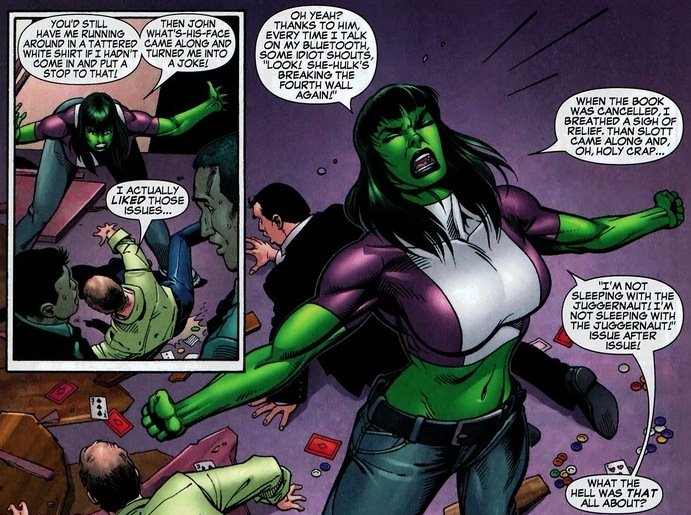

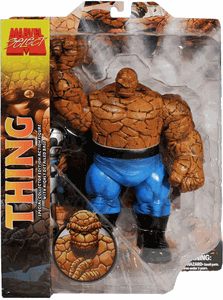
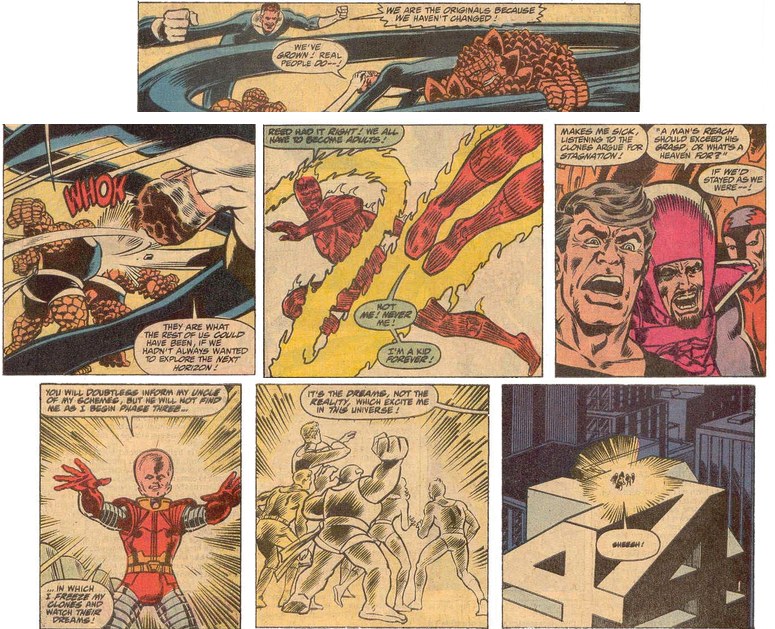
In his final two frames, Englehart (as
John Harkness) admits that the situation is completely broken and
it would take a better man than him to fix it.
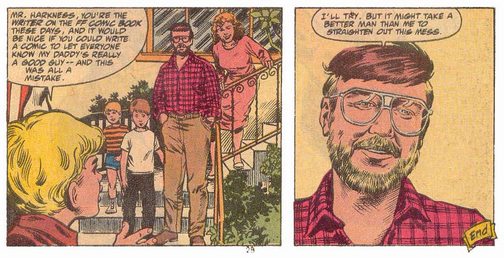
Jonathan Nolan on the FF being forgotten
Other pages discuss how Marvel's success was based on realism, how abandoning real time made realism impossible, and how the Marvel Universe was effectively dead by 1991. The loss of realism in the Fantastic Four was an early warning, as Jonathan Nolan writes:
"Re: the 1990s, one horrifying
feature of the time of the great darkness was that the Fantastic Four
were not only done badly and were out of character, they were moved from
the central position of authority- as BEING the whole marvel universe
in a way- to just being a boring "old" superhero team. In direct
proportion to how many ex-DC people worked at Marvel, the FF were moved
further and further away from center stage, and in effect the conscience
of the marvel universe went with them. The fortunes of Marvel are very
closely tied to the Fantastic Four because their adventures provide the
template for successful Marvel magic"
The sad thing is that the template is so simple. This is not rocket science. But it means risking real change, and that terrifies the powers that be.
